Alteration Lithogeochemistry of an Archean Porphyry-Type Au(-Cu) Setting: The World-Class Côté Gold Deposit, Canada
Abstract
1. Introduction
2. Regional Geological Setting
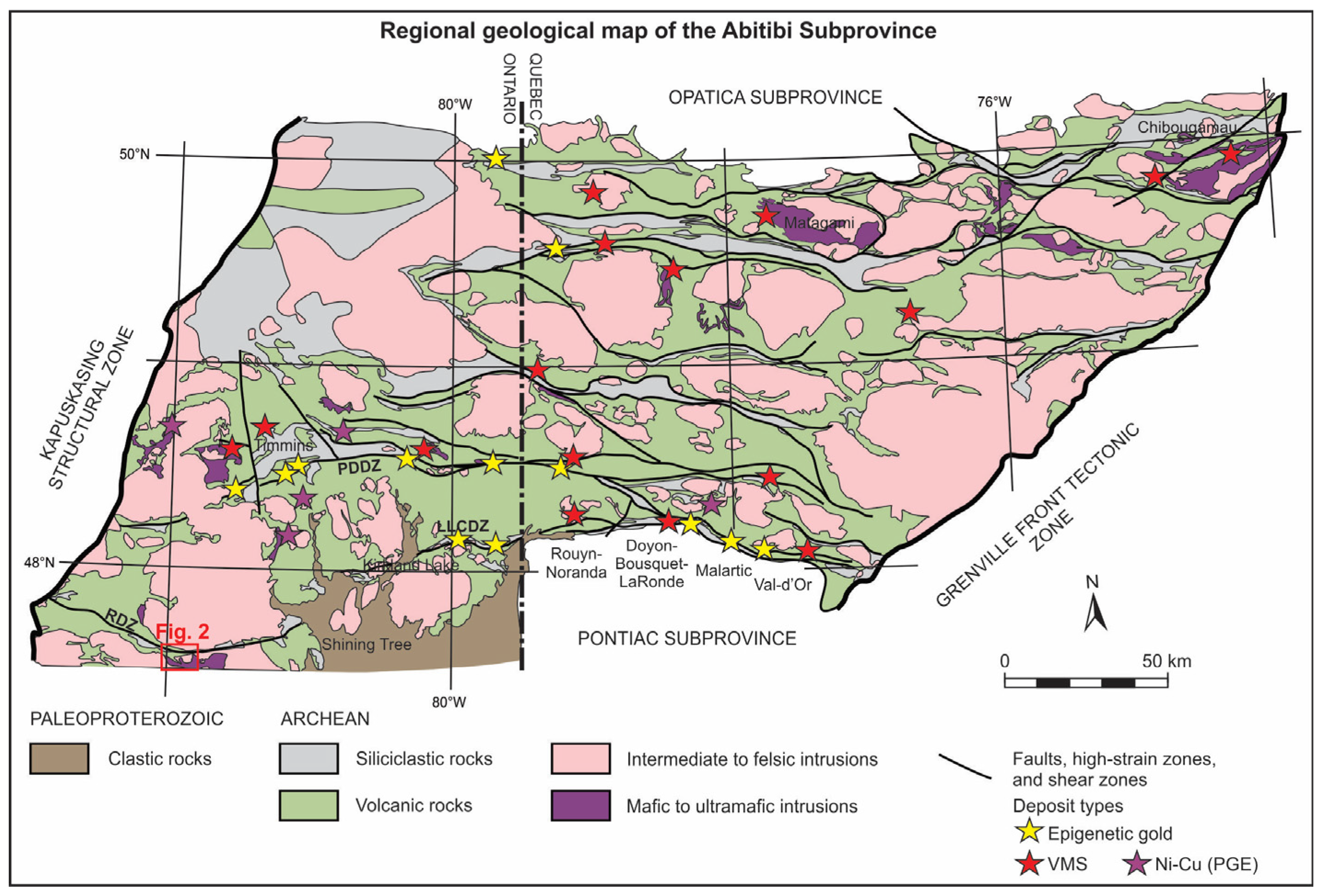
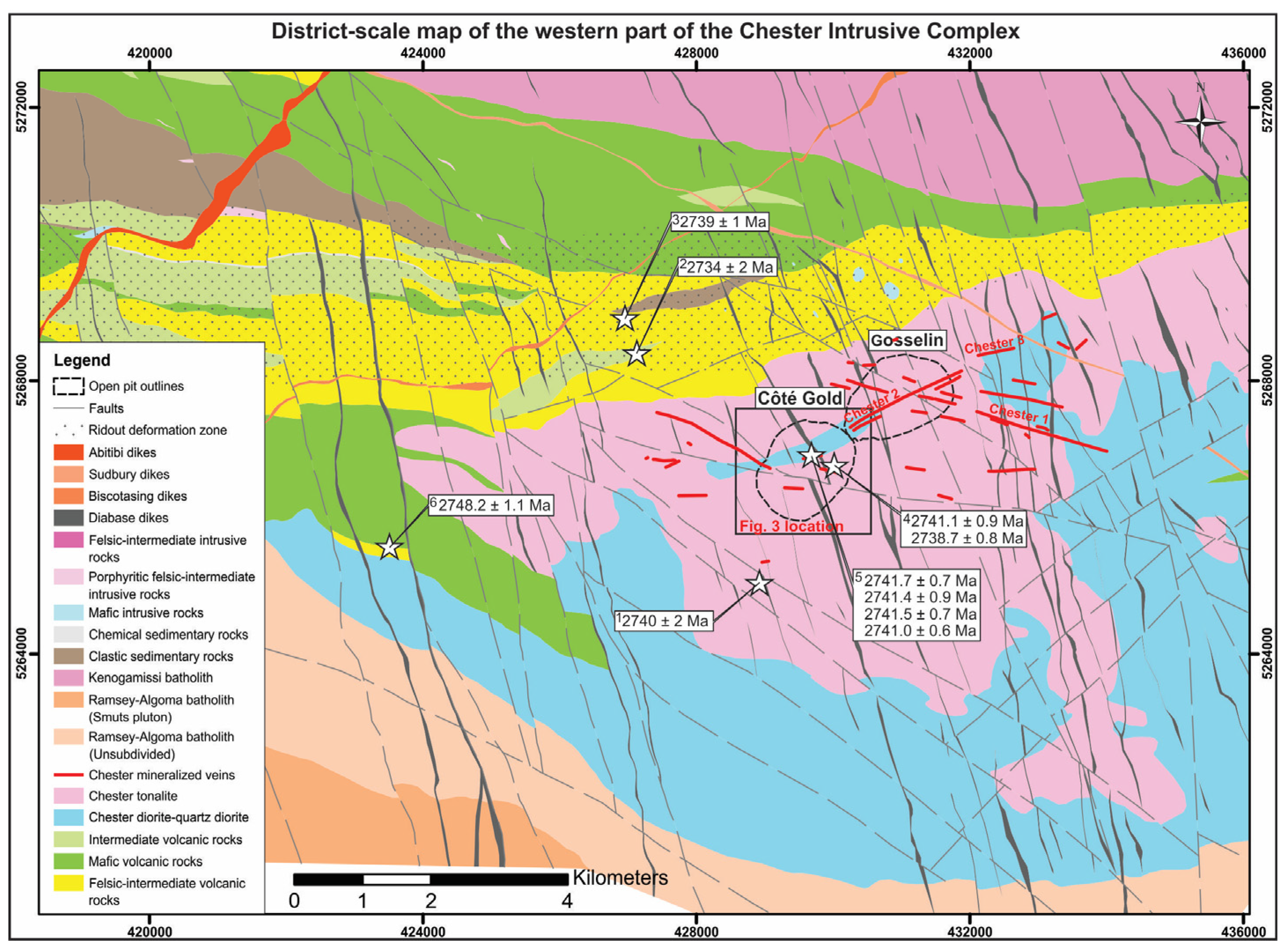
3. Deposit Geology and Alteration Stages
3.1. Magmatic and Magmatic-Hydrothermal Phases of the Chester Intrusive Complex
3.2. Alteration Stages, Breccia Cement and Mineralization
3.3. Post-Emplacement Dikes and Deformation
4. Methodology
4.1. Petrography
4.2. Laser Ablation-Inductively Coupled Plasma-Mass Spectrometry
4.3. Lithogeochemistry
4.4. Mineral Characterization
4.5. Mass Balance
5. Results
5.1. Alteration Geochemistry and Elemental Behavior and Trends


5.2. Rare Earth Element Geochemistry
5.3. Whole-Rock Lithogeochemistry and Metal Associations
5.4. Chalcopyrite Chemistry
5.5. Mass Balance
6. Discussion
6.1. Classification of the Côté Gold Deposit
6.2. Chemical Signatures of Alteration Stages
6.3. Implications of REE Enrichments and Depletions
6.4. Metal Associations and Zoning
6.5. Genetic Model and Exploration Implications
7. Conclusions
Supplementary Materials
Author Contributions
Funding
Data Availability Statement
Acknowledgments
Conflicts of Interest
References
- Černý, P.; Blevin, P.L.; Cuney, M.; London, D. Granite-Related Ore Deposits. In One Hundredth Anniversary Volume; Society of Economic Geologists: Littleon, CO, USA, 2005; pp. 337–370. ISBN 978-1-887483-01-8. [Google Scholar]
- Goldfarb, R.J.; Baker, T.; Dubé, B.; Groves, D.I.; Hart, C.J.R.; Gosselin, P. Distribution, Character, and Genesis of Gold Deposits in Metamorphic Terranes; Society of Economic Geologists: Littleton, CO, USA, 2005; pp. 407–450. [Google Scholar]
- Seedorff, E.; Dilles, J.H.; Proffett, J.M., Jr.; Einaudi, M.T.; Zurcher, L.; Stavast, W.J.A.; Johnson, D.A.; Barton, M.D. Porphyry Deposits: Characteristics and Origin of Hypogene Features; Society of Economic Geologists: Littleton, CO, USA, 2005. [Google Scholar]
- Sillitoe, R.H. Porphyry Copper Systems. Econ. Geol. 2010, 105, 3–41. [Google Scholar] [CrossRef]
- Baker, M.J.; Wilkinson, J.J.; Wilkinson, C.C.; Cooke, D.R.; Ireland, T. Epidote trace element chemistry as an exploration tool in the Collahuasi district, northern Chile. Economic Geology 2020, 115, 749–770. [Google Scholar] [CrossRef]
- Wilkinson, J.J.; Baker, M.J.; Cooke, D.R.; Wilkinson, C.C. Exploration targeting in porphyry Cu systems using propylitic mineral chemistry: A case study of the El Teniente deposit, Chile. Economic Geology 2020, 115, 771–791. [Google Scholar] [CrossRef]
- McCuaig, T.C.; Kerrich, R. P—T—T—Deformation—Fluid Characteristics of Lode Gold Deposits: Evidence from Alteration Systematics. Ore Geol. Rev. 1998, 12, 381–453. [Google Scholar] [CrossRef]
- Rogers, J.R.; Beilhartz, D.; Kontak, D.J.; Katz, L.; Dubé, B.; McNicoll, V. The Côté Gold Deposit: Discovery of a New Generation Low-Grade, Multi-Million Ounce Gold Resource in the Archean Superior Province of Canada. In Proceedings of the NewGenGold Conference, Perth, Australia, 26–27 November 2013; pp. 159–174. [Google Scholar]
- IAMGOLD. Technical Report on the Côté Gold Project; Report for NI 43-101; Iamgold: Toronto, ON, Canada, 2022. [Google Scholar]
- Katz, L.R.; Kontak, D.J.; Dubé, B.; McNicoll, V.; Creaser, R.; Petrus, J.A. An Archean Porphyry-Type Gold Deposit: The Côté Gold Au(-Cu) Deposit, Swayze Greenstone Belt, Superior Province, Ontario, Canada. Econ. Geol. 2021, 116, 47–89. [Google Scholar] [CrossRef]
- Kontak, D.J.; Creaser, R.A.; Hamilton, M.A. Geological and Geochemical Studies of the Côté Lake Au(-Cu) Deposit Area, Chester Township, Northern Ontario. In Results from the Shining Tree, Chester Township and Matachewan Gold Projects and the Northern Cobalt Embayment Polymetallic Vein Project; Ontario Geological Survey: Sudbury, ON, Canada, 2013; pp. 1–38. [Google Scholar]
- Katz, L.R.; Kontak, D.J.; Dubé, B.; McNicoll, V. The Geology, Petrology, and Geochronology of the Archean Côté Gold Large-Tonnage, Low-Grade Intrusion-Related Au(–Cu) Deposit, Swayze Greenstone Belt, Ontario, Canada. Can. J. Earth Sci. 2017, 54, 173–202. [Google Scholar] [CrossRef]
- Dubé, B.; Mercier-Langevin, P. Chapter 32: Gold Deposits of the Archean Abitibi Greenstone Belt, Canada. In Geology of the World’s Major Gold Deposits and Provinces; Sillitoe, R.H., Goldfarb, R.J., Robert, F., Simmons, S.F., Eds.; Society of Economic Geologist: Littleton, CO, USA, 2020; pp. 669–708. ISBN 978-1-62949-312-1. [Google Scholar]
- Gourcerol, B.; Kontak, D.J.; Thurston, P.C.; Tuba, G.; Katz, L. Reconstruction of the Pressure-Temperature-Composition Conditions of an Archean Porphyry-Type Deposit: The 2740 Ma Cóté Gold Au(-Cu) Deposit, Canada. In Proceedings of the Program with Abstracts, Nancy, France, 23–29 June 2017. [Google Scholar]
- Ayer, J.; Amelin, Y.; Corfu, F.; Kamo, S.; Ketchum, J.; Kwok, K.; Trowell, N. Evolution of the Southern Abitibi Greenstone Belt Based on U–Pb Geochronology: Autochthonous Volcanic Construction Followed by Plutonism, Regional Deformation and Sedimentation. Precambrian Res. 2002, 115, 63–95. [Google Scholar] [CrossRef]
- van Breemen, O.; Heather, K.B.; Ayer, J.A. U-Pb Geochronology of the Neoarchean Swayze Sector of the Southern Abitibi Greenstone Belt; Geological Survey of Canada: Ottawa, ON, Canada, 2006. [Google Scholar]
- Thurston, P.C.; Ayer, J.A.; Goutier, J.; Hamilton, M.A. Depositional Gaps in Abitibi Greenstone Belt Stratigraphy: A Key to Exploration for Syngenetic Mineralization. Econ. Geol. 2008, 103, 1097–1134. [Google Scholar] [CrossRef]
- Heather, K.B. The Geological Evolution of the Archean Swayze Greenstone Belt, Superior Province, Canada. Ph.D. Thesis, University of Keele, Keele, UK, 2001. [Google Scholar]
- Gemmell, T.P.; MacDonald, P.J. Precambrian Geology of the Yeo and Chester Townships Area. Chester Intrusive Complex, Southern Abitibi Greenstone Belt: Ontario Geological Survey, Preliminary Map. 2017. Available online: https://www.geologyontario.mines.gov.on.ca/publication/P3817 (accessed on 15 February 2025).
- Monecke, T.; Mercier-Langevin, P.; Dubé, B.; Frieman, B.M. Geology of the Abitibi Greenstone Belt. In Archean Base and Precious Metal Deposits, Southern Abitibi Greenstone Belt, Canada; Monecke, T., Mercier-Langevin, P., Dubé, B., Eds.; Society of Economic Geologists: Littleton, CO, USA, 2017; pp. 7–49. ISBN 978-1-62949-220-9. [Google Scholar]
- Heather, K.B.; van Breemen, O. An Interim Report on Geological, Structural, and Geochronological Investigations of Granitoid Rocks in the Vicinity of the Swayze Greenstone Belt, Southern Superior Province, Ontario. Geol. Surv. Can. Pap. 1994, 259–268. [Google Scholar] [CrossRef]
- Heather, K.B.; Shore, G.T. Geology, Swayze Greenstone Belt, Ontario. Open File; Ontario Geological Survey: Sudbury, ON, Canada, 1999. [Google Scholar]
- Heather, K.B.; Shore, G.T. Geology, Gogama, Swayze Greenstone Belt, Ontario. Open File; Ontario Geological Survey: Sudbury, ON, Canada, 1999. [Google Scholar]
- Hastie, E.C.G.; Kontak, D.J.; Lafrance, B. Gold remobilization: Insights from gold deposits in the Archean Swayze greenstone belt, Abitibi Subprovince, Canada. Econ. Geol. 2020, 115, 241–277. [Google Scholar] [CrossRef]
- Hastie, E.C.G.; Kontak, D.J.; Lafrance, B.; Petrus, J.A.; Sharpe, R.; Fayek, M. Evaluating geochemical discriminants in Archean Au deposits: A Superior Province perspective with an emphasis on the Abitibi greenstone belt. Econ. Geol. 2023, 118, 123–155. [Google Scholar] [CrossRef]
- Siragusa, G.M. Geology, Geochemistry and Mineralization of the Southern Margin of the Swayze Belt; Ontario Geological Survey: Sudbury, ON, Canada, 1993; pp. 1–144. [Google Scholar]
- Fumerton, S.; Houle, K. Mineral Showings, Occurrences, Deposits and Mines of the Swayze Greenstone Belt, Interim Report; Open File Report 5871; Ontario Geological Survey: Sudbury, ON, Canada, 1993; 112p. [Google Scholar]
- Heather, K.B.; Percival, J.A.; Moser, D.; Bleeker, W. Tectonics and Metallogeny of Archean Crust in the Abitibi-Kapuskasing-Wawa Region; Geological Survey of Canada: Ottawa, ON, Canada, 1995; pp. 1–148. [Google Scholar]
- Powell, W.G.; Carmichael, D.M.; Hodgson, C.J. Conditions and Timing of Metamorphism in the Southern Abitibi Greenstone Belt, Quebec. Can. J. Earth Sci. 1995, 32, 787–805. [Google Scholar] [CrossRef]
- Heather, K.B. Regional Geology, Structure, and Mineral Deposits of the Archean Swayze Greenstone Belt, Southern Superior Province, Ontario; Current Research, Part C; Geological Survey of Canada: Ottawa, ON, Canada, 1993; pp. 295–305. [Google Scholar]
- Berger, B.R. Geological investigations south of Gogama. In Summary of Field Work and Other Activities 2011; Open File Report 6270; Ontario Geological Survey: Sudbury, ON, Canada, 2011; pp. 1–7. [Google Scholar]
- Barker, F. Trondhjemites, Dacites and Related Rocks; Elsevier: New York, NY, USA, 1979. [Google Scholar]
- Meyer, C.; Hemley, J.J. Wall Rock Alteration. In Geochemistry of Hydrothermal Ore Deposits; Holt: Winston, NY, USA, 1967; pp. 166–235. [Google Scholar]
- Galley, A.G.; Hannington, M.D.; Jonasson, I.R. Volcanogenic Massive Sulphide Deposits. In Mineral Deposits of Canada: A Synthesis of Major Deposit-Types, District Metallogeny, the Evolution of Geological Provinces, and Exploration Methods; Special Publication; Geological Association of Canada: St. John’s, NL, Canada, 2007; pp. 141–161. [Google Scholar]
- Suikkanen, E.; Rämö, O.T. Episyenites—Characteristics, Genetic Constraints, and Mineral Potential. Min. Metall. Explor. 2019, 36, 861–878. [Google Scholar] [CrossRef]
- Müller, W.; Shelley, M.; Miller, P.; Broude, S. Initial Performance Metrics of a New Custom-Designed ArF Excimer LA-ICPMS System Coupled to a Two-Volume Laser-Ablation Cell. J. Anal. At. Spectrom. 2009, 24, 209–214. [Google Scholar] [CrossRef]
- Paton, C.; Hellstrom, J.; Paul, B.; Woodhead, J.; Hergt, J. Iolite: Freeware for the Visualisation and Processing of Mass Spectrometric Data. J. Anal. At. Spectrom. 2011, 26, 2508–2518. [Google Scholar] [CrossRef]
- Sylvester, P.J.; Cabri, L.J.; Tubrett, M.N.; McMahon, G.; Laflamme, J.H.G.; Peregoedova, A. Synthesis and Evaluation of a Fused Pyrrhotite Standard Reference Material for Platinum Group Element and Gold Analysis by Laser Ablation-ICPMS; Geological Survey of Finland: Oulu, Finland, 2005; pp. 16–20. [Google Scholar]
- Katz, L.R.; Kontak, D.J.; Dubé, B.; Mercier-Langevin, P.; Bécu, V.; Lauzière, K. Whole-Rock Lithogeochemistry of the Archean Intrusion-Related Côté Gold Au(-Cu) Deposit, Ontario, Canada; Geological Survey of Canada: Ottawa, ON, Canada, 2016; pp. 1–5. [Google Scholar]
- Grant, J.A. The Isocon Diagram; a Simple Solution to Gresens’ Equation for Metasomatic Alteration. Econ. Geol. 1986, 81, 1976–1982. [Google Scholar] [CrossRef]
- Brodbeck, M.; McClenaghan, S.H.; Kamber, B.S.; Redmond, P.B. Metal(Loid) Deportment in Sulfides from the High-Grade Core of the Bingham Canyon Porphyry Cu-Mo-Au Deposit, Utah. Econ. Geol. 2022, 117, 1521–1542. [Google Scholar] [CrossRef]
- Rollinson, H.R. Using Geochemical Data: Evaluation, Presentation, Interpretation; Longman Geochemistry Series; Taylor and Francis: Hoboken, NJ, USA, 2014; ISBN 978-0-582-06701-1. [Google Scholar]
- Sun, S.-S.; McDonough, W.F. Chemical and Isotopic Systematics of Oceanic Basalts: Implications for Mantle Composition and Processes; Geological Society: London, UK, 1989; Volume 42, pp. 313–345. [Google Scholar] [CrossRef]
- Petersen, M.D. The Use of the “Immobile” Elements Zr and Ti in Lithogeochemical Exploration for Massive Sulphide Deposits in the Precambrian Pecos Greenstone Belt of Northern New Mexico. J. Geochem. Explor. 1983, 19, 615–617. [Google Scholar] [CrossRef]
- Petersson, J.; Eliasson, T. Mineral Evolution and Element Mobility during Episyenitization (Dequartzification) and Albitization in the Postkinematic Bohus Granite, Southwest Sweden. Lithos 1997, 42, 123–146. [Google Scholar] [CrossRef]
- Corfu, F.; Hanchar, J.M.; Hoskin, P.W.O.; Kinny, P. Atlas of Zircon Textures. Rev. Mineral. Geochem. 2003, 53, 469–500. [Google Scholar] [CrossRef]
- Putnis, A. Mineral replacement reactions: From macroscopic observations to microscopic mechanisms. Mineral. Mag. 2002, 66, 689–708. [Google Scholar] [CrossRef]
- Hoskin, P.W.O.; Schaltegger, U. The composition of zircon and igneous and metamorphic petrogenesis. Rev. Mineral. Geochem. 2003, 53, 27–62. [Google Scholar] [CrossRef]
- Schaltegger, U. Hydrothermal zircon. Elements 2007, 3, 51–79. [Google Scholar] [CrossRef]
- Toscano, M.; Pascual, E.; Nesbitt, R.W.; Almodóvar, G.R.; Sáez, R.; Donaire, T. Geochemical discrimination of hydrothermal and igneous zircon in the Iberian Pyrite Belt, Spain. Ore Geol. Rev. 2014, 56, 301–311. [Google Scholar] [CrossRef]
- Taylor, R.P.; Fryer, B.J. Multiple-Stage Hydrothermal Alteration in Porphyry Copper Systems in Northern Turkey: The Temporal Interplay of Potassic, Propylitic, and Phyllic Fluids. Can. J. Earth Sci. 1980, 17, 901–926. [Google Scholar] [CrossRef]
- Taylor, R.P.; Fryer, B.J. Rare Earth Element Geochemistry as an Aid to Interpreting Hydrothermal Ore Deposits. In Metallization Associated with Acid Magmatism; John Wiley: New York, NY, USA, 1982; pp. 57–65. [Google Scholar]
- Taylor, R.P.; Fryer, B.J. Rare Earth Element Lithogeochemistry of Granitoid Mineral Deposits. Bull. Can. Inst. Mine Metall. 1983, 76, 74–84. [Google Scholar]
- Palacios, C.M.; Hein, U.F.; Dulski, P. Behaviour of Rare Earth Elements during Hydrothermal Alteration at the Buena Esperanza Copper-Silver Deposit, Northern Chile. Earth Planet. Sci. Lett. 1986, 80, 208–216. [Google Scholar] [CrossRef]
- Schneider, H.J.; Oezguer, N.; Palacios, C.M. Relationship between Alteration, Rare Earth Element Distribution, and Mineralization of the Murgul Copper Deposit, Northeastern Turkey. Econ. Geol. 1988, 83, 1238–1246. [Google Scholar] [CrossRef]
- Ward, C.D.; Mcarthur, J.M.; Walsh, J.N. Rare Earth Element Behaviour During Evolution and Alteration of the Dartmoor Granite, SW England. J. Petrol. 1992, 33, 785–815. [Google Scholar] [CrossRef]
- Poitrasson, F.; Pin, C.; Duthou, J.-L. Hydrothermal Remobilization of Rare Earth Elements and Its Effect on Nd Isotopes in Rhyolite and Granite. Earth Planet. Sci. Lett. 1995, 130, 1–11. [Google Scholar] [CrossRef]
- Fulignati, P.; Gioncada, A.; Sbrana, A. Rare-Earth Element (REE) Behaviour in the Alteration Facies of the Active Magmatic–Hydrothermal System of Vulcano (Aeolian Islands, Italy). J. Volcanol. Geotherm. Res. 1999, 88, 325–342. [Google Scholar] [CrossRef]
- Parsapoor, A.; Khalili, M.; Mackizadeh, M.A. The Behaviour of Trace and Rare Earth Elements (REE) during Hydrothermal Alteration in the Rangan Area (Central Iran). J. Asian Earth Sci. 2009, 34, 123–134. [Google Scholar] [CrossRef]
- Al-Ani, T.; Ahtola, T.; Kuusela, J.; Al-Ansari, N. Mineralogical and Petrographic Characteristics of Indium and REE-Bearing Accessory Phases in the Kymi Granite Stock, Southern Finland. Nat. Resour. 2018, 9, 23–41. [Google Scholar] [CrossRef]
- Kontonikas-Charos, A.; Ciobanu, C.L.; Cook, N.J. Albitization and Redistribution of REE and Y in IOCG Systems: Insights from Moonta-Wallaroo, Yorke Peninsula, South Australia. Lithos 2014, 208–209, 178–201. [Google Scholar] [CrossRef]
- Song, S.; Mao, J.; Xie, G.; Chen, L.; Santosh, M.; Chen, G.; Rao, J.; Ouyang, Y. In situ LA-ICP-MS U–Pb geochronology and trace element analysis of hydrothermal titanite from the giant Zhuxi W (Cu) skarn deposit, South China. Miner. Depos. 2019, 54, 569–590. [Google Scholar] [CrossRef]
- Bruand, E.; Fowler, M.; Storey, C.; Laurent, O.; Antoine, C.; Guitreau, M.; Heilimo, E.; Nebel, O.; Bruand, E.; Fowler, M.; et al. Accessory mineral constraints on crustal evolution: Elemental fingerprints for magma discrimination. Geochem. Perspect. Lett. 2020, 13, 7–12. [Google Scholar] [CrossRef]
- Johnson, C.A. Partitioning of Zinc among Common Ferromagnesian Minerals and Implications for Hydrothermal Mobilization. Can. Miner. 1994, 32, 121–132. [Google Scholar]
- Foster, M.D. Interpretation of the Composition of Trioctahedral Micas; Professional Paper; US Geological Survey: Reston, VA, USA, 1960; Volume 354-B, pp. 1–146. [Google Scholar]
- Prendergast, K. Application of Lithogeochemistry to Gold Exploration in the St Ives Goldfield, Western Australia. Geochem. Explor. Environ. Anal. 2007, 7, 99–108. [Google Scholar] [CrossRef]
- Harris, J.R.; Wilkinson, L.; Grunsky, E.; Heather, K.; Ayer, J. Techniques for Analysis and Visualization of Lithogeochemical Data with Applications to the Swayze Greenstone Belt, Ontario. J. Geochem. Explor. 1999, 67, 301–334. [Google Scholar] [CrossRef]
- Byrne, K.; Lesage, G.; Gleeson, S.A.; Piercey, S.J.; Lypaczewski, P.; Kyser, K. Linking Mineralogy to Lithogeochemistry in the Highland Valley Copper District: Implications for Porphyry Copper Footprints. Econ. Geol. 2020, 115, 871–901. [Google Scholar] [CrossRef]
- Robert, F.; Poulsen, K.H.; Dubé, B. Gold deposits and their geological classification. In Proceedings of the Exploration 97: Fourth Decennial International Conference on Mineral Exploration, Toronto, ON, Canada, 14–18 September 1997; Gubins, A.G., Ed.; Exploration Geochemistry: Toronto, ON, Canada, 1997; pp. 209–220. [Google Scholar]
- Carranza, E.J.M.; Sadeghi, M. Primary geochemical characteristics of mineral deposits – implications for exploration. Ore Geol. Rev. 2012, 45, 1–4. [Google Scholar] [CrossRef]
- Cohen, D.R.; Bowell, R.J. Exploration geochemistry. In Treatise on Geochemistry, 2nd ed.; Holland, H.D., Turekian, K.K., Eds.; Elsevier: Oxford, UK, 2014; Volume 13, pp. 623–649. [Google Scholar] [CrossRef]
- Halley, S.; Dilles, J.H.; Tosdal, R.M. Footprints: Hydrothermal alteration and geochemical dispersion around porphyry copper deposits. Soc. Econ. Geol. Newsl. 2015, No. 100, 11–17. [Google Scholar] [CrossRef]
- Kyser, K.; Barr, J.; Ihlenfeld, C. Applied geochemistry in mineral exploration and mining. Elements 2015, 11, 241–246. [Google Scholar] [CrossRef]
- Gaillard, N.; Williams-Jones, A.E.; Clark, J.R.; Salvi, S.; Perrouty, S.; Linnen, R.L.; Olivo, G.R. The use of lithogeochemistry in delineating hydrothermal fluid pathways and vectoring gold mineralization in the Malartic district, Québec. Ore Geol. Rev. 2020, 120, 103351. [Google Scholar] [CrossRef]
- Williams-Jones, A.E.; Heinrich, C.A. Vapor transport of metals and the formation of magmatic-hydrothermal ore deposits. Econ. Geol. 2005, 100, 1287–1312. [Google Scholar] [CrossRef]
- Dubé, B.; Gosselin, P. Greenstone-Hosted Quartz-Carbonate Vein Deposits. In Mineral Deposits of Canada: A Synthesis of Major Deposit-Types, District Metallogeny, the Evolution of Geological Provinces, and Exploration Methods; Special Publication 5; Geological Association of Canada, Mineral Deposits Division: St. John’s, NL, Canada, 2007; pp. 49–73. [Google Scholar]
- Groves, D.I.; Goldfarb, R.J.; Robert, F.; Hart, C.J.R. Gold Deposits in Metamorphic Belts: Overview of Current Understanding, Outstanding Problems, Future Research, and Exploration Significance. Econ. Geol. 2003, 98, 1–29. [Google Scholar] [CrossRef]
- Goldfarb, R.J.; Phillips, G.N.; Nokleberg, W.J. Tectonic setting of synorogenic gold deposits of the Pacific Rim. Ore Geol. Rev. 1998, 13, 185–218. [Google Scholar] [CrossRef]
- Groves, D.I.; Goldfarb, R.J.; Gebre-Mariam, M.; Hagemann, S.G.; Robert, F. Orogenic gold deposits: A proposed classification in the context of their crustal distribution and relationship to other gold deposit types. Ore Geol. Rev. 1998, 13, 7–27. [Google Scholar] [CrossRef]
- Goldfarb, R.J.; Pitcairn, I. Orogenic gold: Is a genetic association with magmatism realistic? Miner. Depos. 2022, 58, 5–35. [Google Scholar] [CrossRef]
- Goodman, S.; Williams-Jones, A.E.; Carles, P. Structral Controls on the Archean Troilus Gold-Copper Deposit, Quebec, Canada. Econ. Geol. 2005, 100, 577–582. [Google Scholar] [CrossRef]
- Fraser, R.J. The Lac Troilus Gold-Copper Deposit, Northwestern Quebec; a Possible Archean Porphyry System. Econ. Geol. 1993, 88, 1685–1699. [Google Scholar] [CrossRef]
- Helt, K.M.; Williams-Jones, A.E.; Clark, J.R.; Wing, B.A.; Wares, R.P. Constraints on the Genesis of the Archean Oxidized, Intrusion-Related Canadian Malartic Gold Deposit, Quebec, Canada. Econ. Geol. 2014, 109, 713–735. [Google Scholar] [CrossRef]
- De Souza, S.; Dubé, B.; Mercier-Langevin, P.; McNicoll, V.; Dupuis, C.; Kjarsgaard, I. Hydrothermal alteration mineralogy and geochemistry of the Archean world-class Canadian Malartic disseminated-stockwork gold deposit, southern Abitibi greenstone belt, Quebec, Canada. Econ. Geol. 2019, 114, 1057–1094. [Google Scholar] [CrossRef]
- Sillitoe, R.H.; Thompson, J.F.H. Intrusion-Related Vein Gold Deposits: Types, Tectono-Magmatic Settings and Difficulties of Distinction from Orogenic Gold Deposits. Resour. Geol. 1998, 48, 237–250. [Google Scholar] [CrossRef]
- Hart, C.J.R. Reduced Intrusion-Related Gold Systems. In Mineral Deposits of Canada: A Synthesis of Major Deposit-Types, District Metallogeny, the Evolution of Geological Provinces, and Exploration Methods; Special Publication No. 5; Geological Association of Canada, Mineral Deposits Division: St. John’s, NL, Canada, 2007; pp. 95–112. [Google Scholar]
- Smith, J. An Integrated Structural and Geochemical Study of Auriferous Sheeted Quartz Veins within the 2740 Ma Cóté Gold Deposit, Swayze Greenstone Belt, Ontario. Unpublished Thesis, Laurentian University, Sudbury, ON, Canada, 2016. [Google Scholar]
- Smith, J.; LaFrance, B.; Kontak, D.J. A Comparative Study of the Deformation History of Auriferous Quartz Veins in the Archean Côté Gold Deposit and the Structural Evolution of the Spatially-Related Ridout Deformation Zone, Swayze Greenstone Belt, Northern Ontario; Geological Association of Canada: Fredericton, NB, Canada, 2014. [Google Scholar]
- Sillitoe, R.H. Gold-rich porphyry copper deposits: Geological model and exploration implications. In Mineral Deposit Modeling; Kirkham, R.V., Sinclair, W.D., Thorpe, R.I., Duke, J.M., Eds.; Geological Association of Canada: St. John’s, NL, Canada, 1993. [Google Scholar]
- Tuba, G.; Kontak, D.J.; Choquette, B.G.; Pfister, J.; Hastie, E.C.G.; van Hees, E.H.P. Fluid Diversity in the Gold-Endowed Archean Orogenic Systems of the Abitibi Greenstone Belt (Canada) I: Constraining the PTX of Prolonged Hydrothermal Systems. Ore Geol. Rev. 2021, 135, 1–31. [Google Scholar] [CrossRef]
- Kontak, D.J.; Tuba, G. How Can Fluid Inclusion Studies Better Constrain Orogenic Gold Deposit Models: Case Studies from the Superior Province and Meguma Terrane, Canada? In Proceedings of the Society for Geology Applied to Mineral Deposits Annual Meeting, Quebec, QC, Canada, 5 February 2017. [Google Scholar]
- Crépon, A.; Mathieu, L.; Kontak, D.J.; Marsh, J.; Hamilton, M.A. An Archean Porphyry-Type Deposit: Cu-Au Mineralization Associated with the Chibougamau Tonalite–Diorite Pluton, Abitibi Greenstone Belt, Canada. Minerals 2024, 14, 1293. [Google Scholar] [CrossRef]
- Ford, J.H. A Chemical Study of Alteration at the Panguna Porphyry Copper Deposit, Bougainville, Papua New Guinea. Econ. Geol. 1978, 73, 703–720. [Google Scholar] [CrossRef]
- Chivas, A.R. Geochemical Evidence for Magmatic Fluids in Porphyry Copper Mineralization. Part 1. Mafic Silicates from the Koloula Igneous Complex. Contrib. Mineral. Petrol. 1982, 78, 389–403. [Google Scholar] [CrossRef]
- Kerrich, R.; Fryer, B.J. Lithophile-Element Systematics of Archean Greenstone Belt Au–Ag Vein Deposits: Implications for Source Processes. Can. J. Earth Sci. 1988, 25, 945–953. [Google Scholar] [CrossRef]
- Rieder, M.; Cavazzini, G.; D’yakonov, Y.S.; Frank-Kamenetskii, V.A.; Gottardi, G.; Guggenheim, S.; Koval’, P.V.; Müller, G.; Neiva, A.M.R.; Radoslovich, E.W.; et al. Nomenclature of the Micas. Mineral. Mag. 1999, 63, 267–279. [Google Scholar] [CrossRef]
- Shannon, R.D. Revised Effective Ionic Radii and Systematic Studies of Interatomic Distances in Halides and Chalcogenides. Acta Crystallogr. 1976, 32, 751–767. [Google Scholar] [CrossRef]
- Ulrich, T.; Heinrich, C.A. Geology and Alteration Geochemistry of the Porphyry Cu-Au Deposit at Bajo de La Alumbrera, Argentina. Econ. Geol. 2001, 96, 1719–1742. [Google Scholar] [CrossRef]
- Idrus, A.; Kolb, J.; Meyer, F.M. Mineralogy, Lithogeochemistry and Elemental Mass Balance of the Hydrothermal Alteration Associated with the Gold-rich Batu Hijau Porphyry Copper Deposit, Sumbawa Island, Indonesia. Resour. Geol. 2009, 59, 215–230. [Google Scholar] [CrossRef]
- Anthony, E.Y.; Titley, S.R. Patterns of Element Mobility during Hydrothermal Alteration of the Sierrita Porphyry Copper Deposit, Arizona. Econ. Geol. 1994, 89, 186–192. [Google Scholar] [CrossRef]
- Jacobs, D.C.; Parry, W.T. Geochemistry of Biotite in the Santa Rita Porphyry Copper Deposit, New Mexico. Econ. Geol. 1979, 74, 860–887. [Google Scholar] [CrossRef]
- Olade, M.A.; Fletcher, W.K. Primary Dispersion of Rubidium and Strontium around Porphyry Copper Deposits, Highland Valley, British Columbia. Econ. Geol. 1975, 70, 15–21. [Google Scholar] [CrossRef]
- Armbrust, G.A.; Oyarzun, M.J.; Arias, J. Rubidium as a Guide to Ore in Chilean Porphyry Copper Deposits. Econ. Geol. 1977, 72, 1086–1100. [Google Scholar] [CrossRef]
- Catchpole, H.; Kouzmanov, K.; Putlitz, B.; Seo, J.H.; Fontbote, L. Zoned Base Metal Mineralization in a Porphyry System: Origin and Evolution of Mineralizing Fluids in the Morococha District, Peru. Econ. Geol. 2015, 110, 39–71. [Google Scholar] [CrossRef]
- Ahrens, L.H. The Use of Ionization Potentials Part 1. Ionic Radii of the Elements. Geochim. Cosmochim. Acta 1952, 2, 155–169. [Google Scholar] [CrossRef]
- Cohen, J.F. Mineralogy and Geochemistry of Hydrothermal Alteration at the Ann-Mason Porphyry Copper Deposit, Nevada: Comparison of Large-Scale Ore Exploration Techniques to Mineral Chemistry. Unpublished Thesis, University of Oregon, Eugene, OR, USA, 2011. [Google Scholar]
- Dostal, J.; Kontak, D.J.; Gerel, O.; Gregory Shellnutt, J.; Fayek, M. Cretaceous Ongonites (Topaz-Bearing Albite-Rich Microleucogranites) from Ongon Khairkhan, Central Mongolia: Products of Extreme Magmatic Fractionation and Pervasive Metasomatic Fluid: Rock Interaction. Lithos 2015, 236–237, 173–189. [Google Scholar] [CrossRef]
- Kontak, D.J.; Dostal, J.; Petrus, J.A. Muscovite as a Monitor of Primary versus Secondary Rare-Metal Enrichment in Albite-Topaz Keratophyres from Ongon Khairkan, Mongolia. In Proceedings of the GAC-MAC-IAH Québec 2019, Québec City, QC, Canada, 12–15 May 2019. [Google Scholar]
- Yin, R.; Han, L.; Huang, X.-L.; Li, J.; Li, W.-X.; Chen, L.-L. Textural and Chemical Variations of Micas as Indicators for Tungsten Mineralization: Evidence from Highly Evolved Granites in the Dahutang Tungsten Deposit, South China. Am. Mineral. 2019, 104, 949–965. [Google Scholar] [CrossRef]
- Derakhshan, R.; Abdolzadeh, M. Geochemistry, Mineralization and Alteration Zones of Darrehzar Porphyry Copper Deposit, Kerman, Iran. J. Appl. Sci. 2009, 9, 1628–1646. [Google Scholar] [CrossRef]
- Ludden, J.N.; Daigneault, R.; Robert, F.; Taylor, R.P. Trace Element Mobility in Alteration Zones Associated with Archean Au Lode Deposits. Econ. Geol. 1984, 79, 1131–1141. [Google Scholar] [CrossRef]
- Gaboury, D. Parameters for the Formation of Orogenic Gold Deposits. Appl. Earth Sci. 2019, 128, 124–133. [Google Scholar] [CrossRef]
- Djouka-Fonkwe, M.L.; Kyser, K.; Clark, A.H.; Urqueta, E.; Oates, C.J.; Ihlenfeld, C. Recognizing Propylitic Alteration Associated with Porphyry Cu-Mo Deposits in Lower Greenschist Facies Metamorphic Terrain of the Collahuasi District, Northern Chile--Implications of Petrographic and Carbon Isotope Relationships. Econ. Geol. 2012, 107, 1457–1478. [Google Scholar] [CrossRef]
- Seedorff, E.; Barton, M.D.; Stavast, W.J.A.; Maher, D.J. Root Zones of Porphyry Systems: Extending the Porphyry Model to Depth. Econ. Geol. 2008, 103, 939–956. [Google Scholar] [CrossRef]
- Sillitoe, R.H. Intrusion-Related Gold Deposits. In Gold Metallogeny and Exploration; Springer: Boston, MA, USA, 1991; pp. 165–209. ISBN 978-1-4612-7837-5. [Google Scholar]
- Lang, J.R.; Baker, T. Intrusion-Related Gold Systems: The Present Level of Understanding. Miner. Depos. 2001, 36, 477–489. [Google Scholar] [CrossRef]
- John, D.A. Geologic Setting, Depths of Emplacement, and Regional Distribution of Fluid Inclusions in Intrusions of the Central Wasatch Mountains, Utah. Econ. Geol. 1989, 84, 386–409. [Google Scholar] [CrossRef]
- Dilles, J.H.; Einaudi, M.T. Wall-Rock Alteration and Hydrothermal Flow Paths about the Ann-Mason Porphyry Copper Deposit, Nevada; a 6-Km Vertical Reconstruction. Econ. Geol. 1992, 87, 1963–2001. [Google Scholar] [CrossRef]
- Ludden, J.N.; Thompson, G. Behaviour of Rare Earth Elements during Submarine Weathering of Tholeiitic Basalt. Nature 1978, 274, 147–149. [Google Scholar] [CrossRef]
- Norman, D.I.; Kyle, P.R.; Baron, C. Analysis of Trace Elements Including Rare Earth Elements in Fluid Inclusion Liquids. Econ. Geol. 1989, 84, 162–166. [Google Scholar] [CrossRef]
- Kerrich, R.; Fryer, B.J. Archaean Precious-Metal Hydrothermal Systems, Dome Mine, Abitibi Greenstone Belt. II. REE and Oxygen Isotope Relations. Can. J. Earth Sci. 1979, 16, 440–458. [Google Scholar] [CrossRef]
- McLellan, S.M.; Taylor, S.R. Rare Earth Element Mobility Associated with Uranium Mineralisation. Nature 1979, 282, 247–250. [Google Scholar] [CrossRef]
- Metz, M.C.; Brookins, D.G.; Rosenberg, P.E.; Zartman, R.E. Geology and Geochemistry of the Snowbird Deposit, Mineral County, Montana. Econ. Geol. 1985, 80, 394–409. [Google Scholar] [CrossRef]
- Lottermoser, B.G. Rare Earth Elements and Hydrothermal Ore Formation Processes. Ore Geol. Rev. 1992, 7, 25–41. [Google Scholar] [CrossRef]
- Williams-Jones, A.E.; Migdisov, A.A.; Samson, I.M. Hydrothermal Mobilisation of the Rare Earth Elements—A Tale of “Ceria” and “Yttria”. Elements 2012, 8, 355–360. [Google Scholar] [CrossRef]
- Lottermoser, B.G. Rare-Earth Element and Heavy-Metal Behaviour Associated with the Epithermal Gold Deposit on Lihir Island, Papua New Guinea. J. Volcanol. Geotherm. Res. 1990, 40, 269–289. [Google Scholar] [CrossRef]
- Flynn, R.T.; Wayne Burnham, C. An Experimental Determination of Rare Earth Partition Coefficients between a Chloride Containing Vapor Phase and Silicate Melts. Geochim. Cosmochim. Acta 1978, 42, 685–701. [Google Scholar] [CrossRef]
- Gustafson, L.B.; Hunt, J.P. The Porphyry Copper Deposit at El Salvador, Chile. Econ. Geol. 1975, 70, 857–912. [Google Scholar] [CrossRef]
- Pat Shanks, W.C. Stable Isotope Geochemistry of Mineral Deposits. In Treatise on Geochemistry; Elsevier: Amsterdam, The Netherlands, 2014; pp. 59–85. ISBN 978-0-08-098300-4. [Google Scholar]
- Alderton, D.H.M.; Pearce, J.A.; Potts, P.J. Rare Earth Element Mobility during Granite Alteration: Evidence from Southwest England. Earth Planet. Sci. Lett. 1980, 49, 149–165. [Google Scholar] [CrossRef]
- Kerrich, R.; Wyman, D.A. The Trace Element Systematics of Igneous Rocks in Mineral Exploration: An Overview. In Trace Element Geochemistry of Volcanic Rocks: Applications for Massive Sulphide Exploration; Short Course Notes; Geological Association of Canada: St. John’s, NL, Canada, 1996; Volume 12, pp. 1–50. [Google Scholar]
- Jones, B.K. Application of Metal Zoning to Gold Exploration in Porphyry Copper Systems. J. Geochem. Explor. 1992, 43, 127–155. [Google Scholar] [CrossRef]
- Clark, G.H. Panguna Copper-Gold Deposit. Aust. Inst. Min. Metall. 1990, 14, 807–1816. [Google Scholar]
- Jones, G.J. The Goonumbla Porphyry Copper Deposits, New South Wales. Econ. Geol. 1985, 80, 591–613. [Google Scholar] [CrossRef]
- Lowell, J.D.; Guilbert, J.M. Lateral and Vertical Alteration-Mineralization Zoning in Porphyry Ore Deposits. Econ. Geol. 1970, 65, 373–408. [Google Scholar] [CrossRef]
- Wilson, J.W.J.; Kesler, S.E.; Cloke, P.L.; Kelly, W.C. Fluid Inclusion Geochemistry of the Granisle and Bell Porphyry Copper Deposits, British Columbia. Econ. Geol. 1980, 75, 45–61. [Google Scholar] [CrossRef]
- Hedenquist, J.W.; Arribas, A., Jr.; Reynolds, T.J. Evolution of an Intrusion-Centered Hydrothermal System; Far Southeast-Lepanto Porphyry and Epithermal Cu-Au Deposits, Philippines. Econ. Geol. 1998, 93, 373–404. [Google Scholar] [CrossRef]
- Ulrich, T.; Günther, D.; Heinrich, C.A. The evolution of a porphyry Cu-Au deposit, based on LA-ICP-MS analysis of fluid inclusions: Bajo de la Alumbrera, Argentina. Econ. Geol. 2001, 96, 1743–1774. [Google Scholar] [CrossRef]
- Meng, X.; Richards, J.P.; Kontak, D.J.; Simon, A.C.; Kleinsasser, J.M.; Marsh, J.H.; Stern, R.A.; Jugo, P.J. Variable Modes of Formation for Tonalite–Trondhjemite–Granodiorite–Diorite (TTG)-Related Porphyry-Type Cu ± Au Deposits in the Neoarchean Southern Abitibi Subprovince (Canada): Evidence from Petrochronology and Oxybarometry. J. Petrol. 2021, 62, 1–29. [Google Scholar] [CrossRef]
- Mole, D.R.; Frieman, B.M.; Thurston, P.C.; Marsh, J.H.; Jørgensen, T.R.C.; Stern, R.A.; Martin, L.A.J.; Lu, Y.J.; Gibson, H.L. Crustal Architecture of the South-East Superior Craton and Controls on Mineral Systems. Ore Geol. Rev. 2022, 148, 105017. [Google Scholar] [CrossRef]
- Dyer, J. Assessing the Nature of Breccia-Textured Rocks from a Au-Mineralized Porphyry-Type Setting in the Archean Chester Intrusive Complex, Northern Ontario. Unpublished Thesis, Laurentian University, Sudbury, ON, Canada, 2020. [Google Scholar]
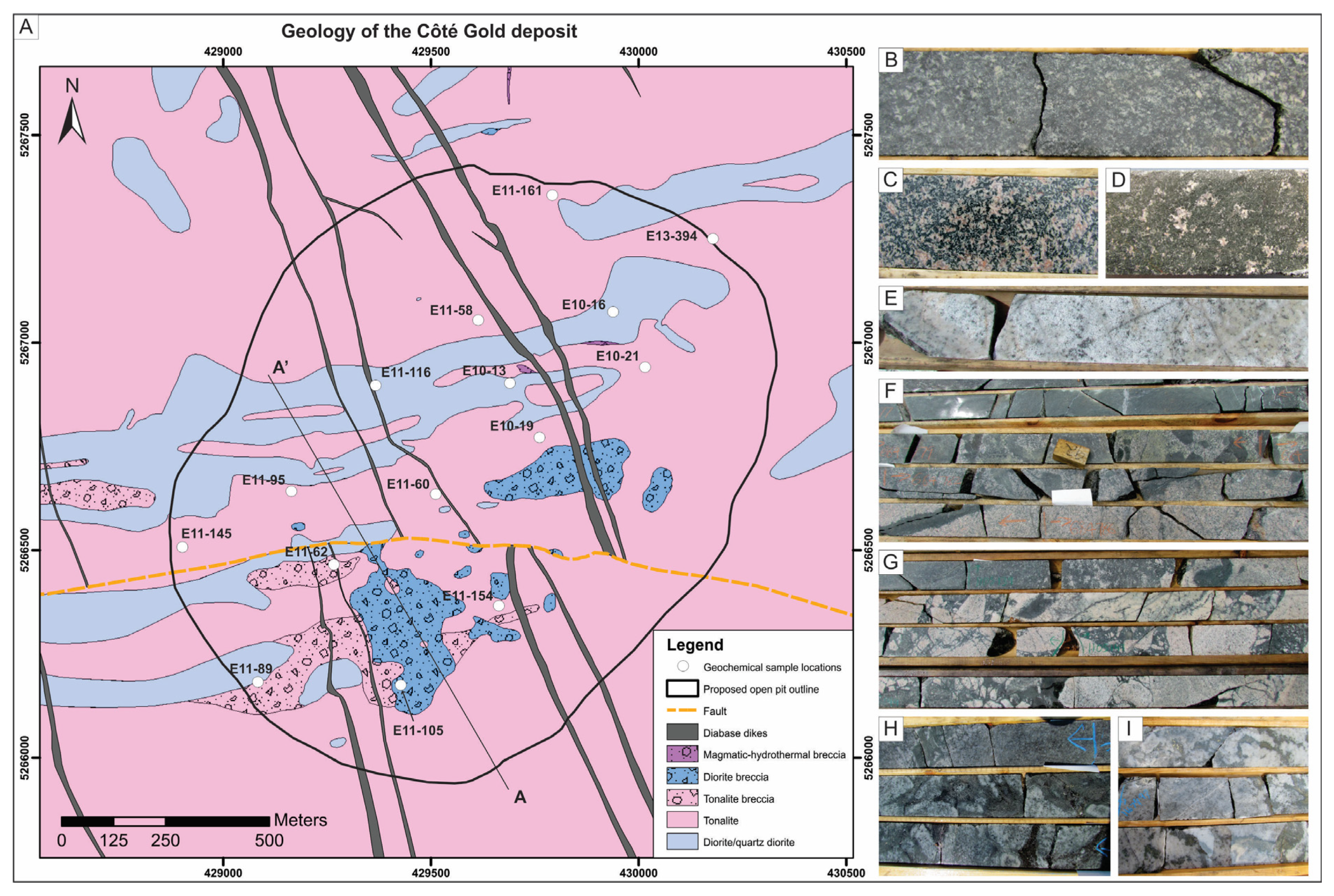

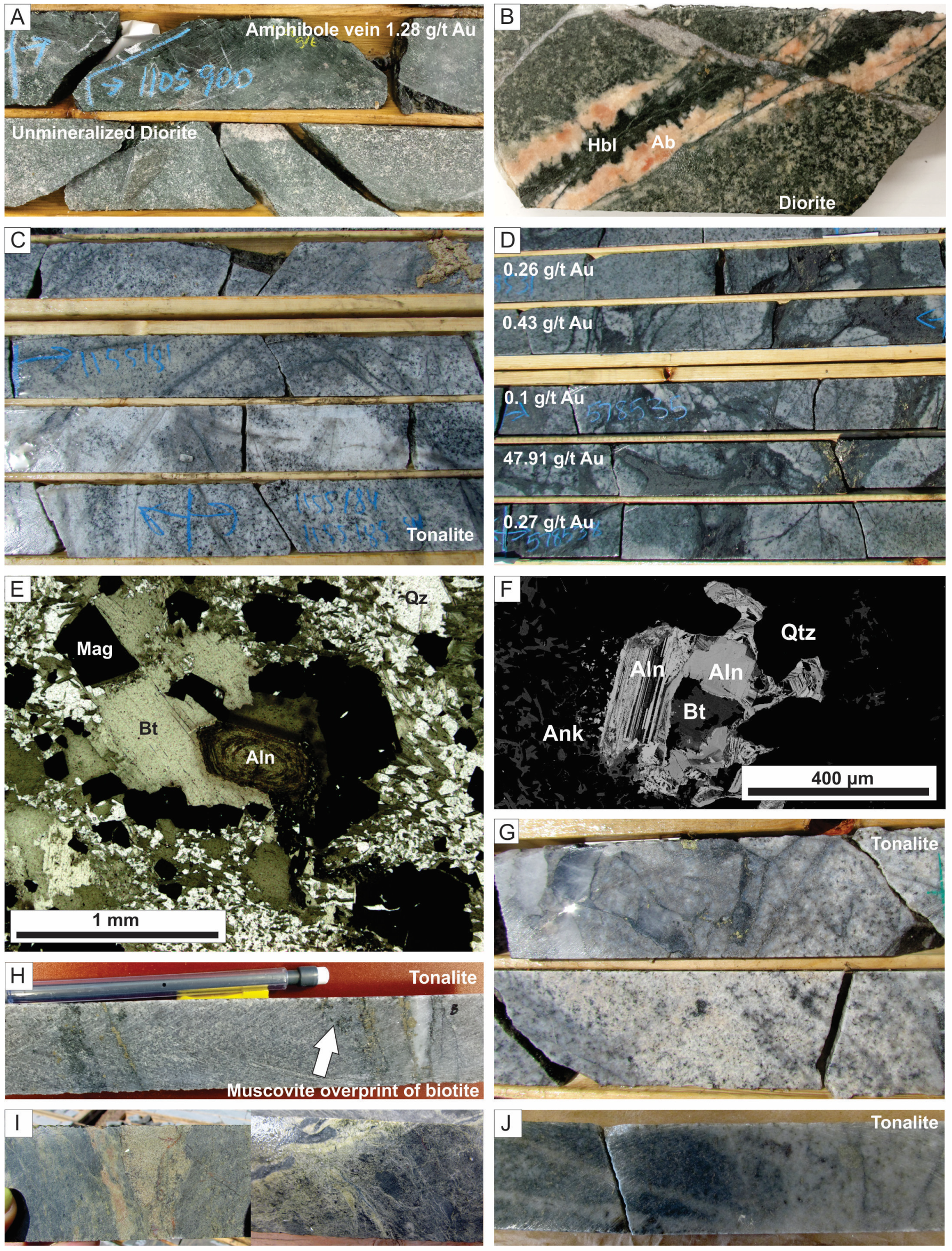
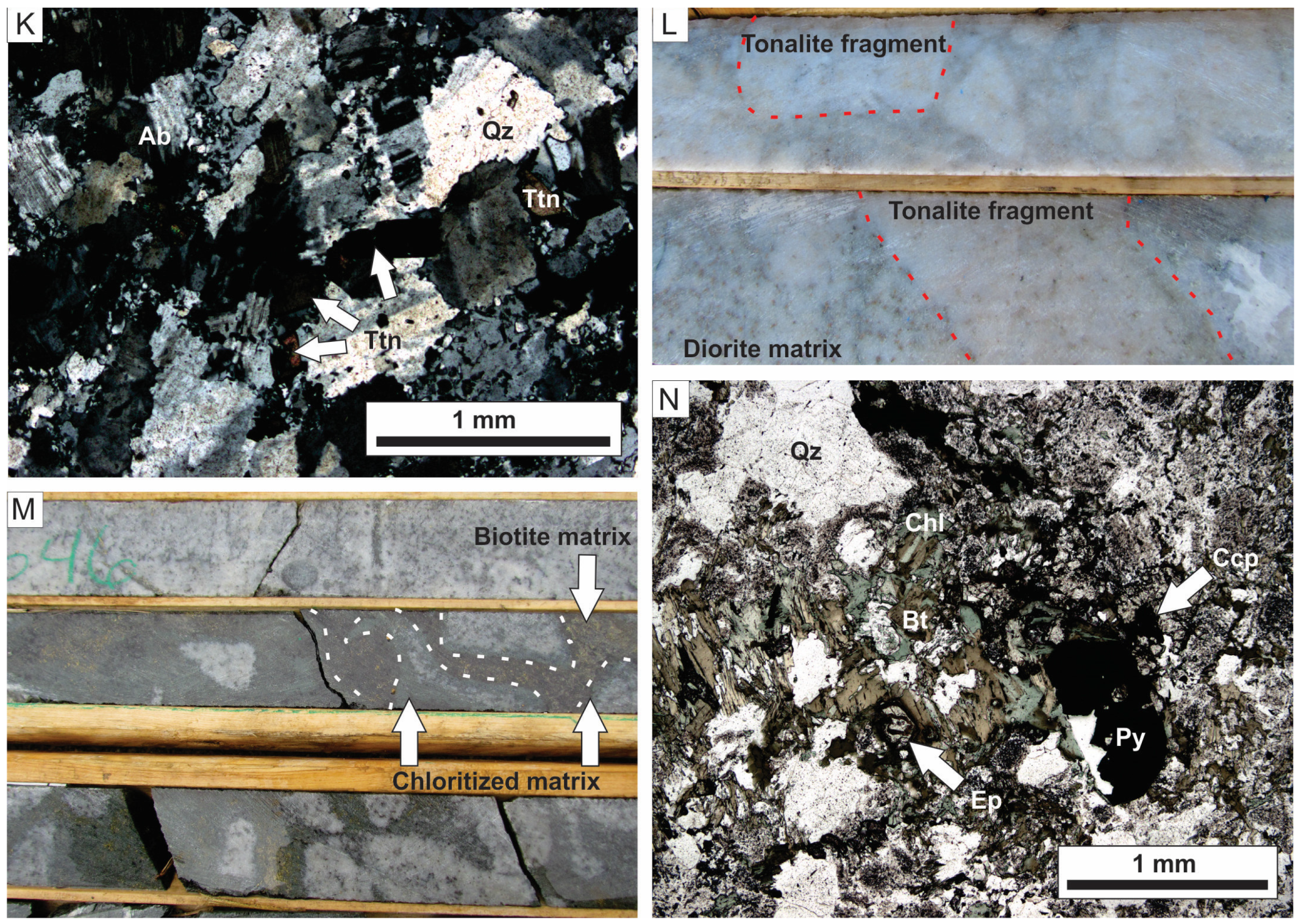
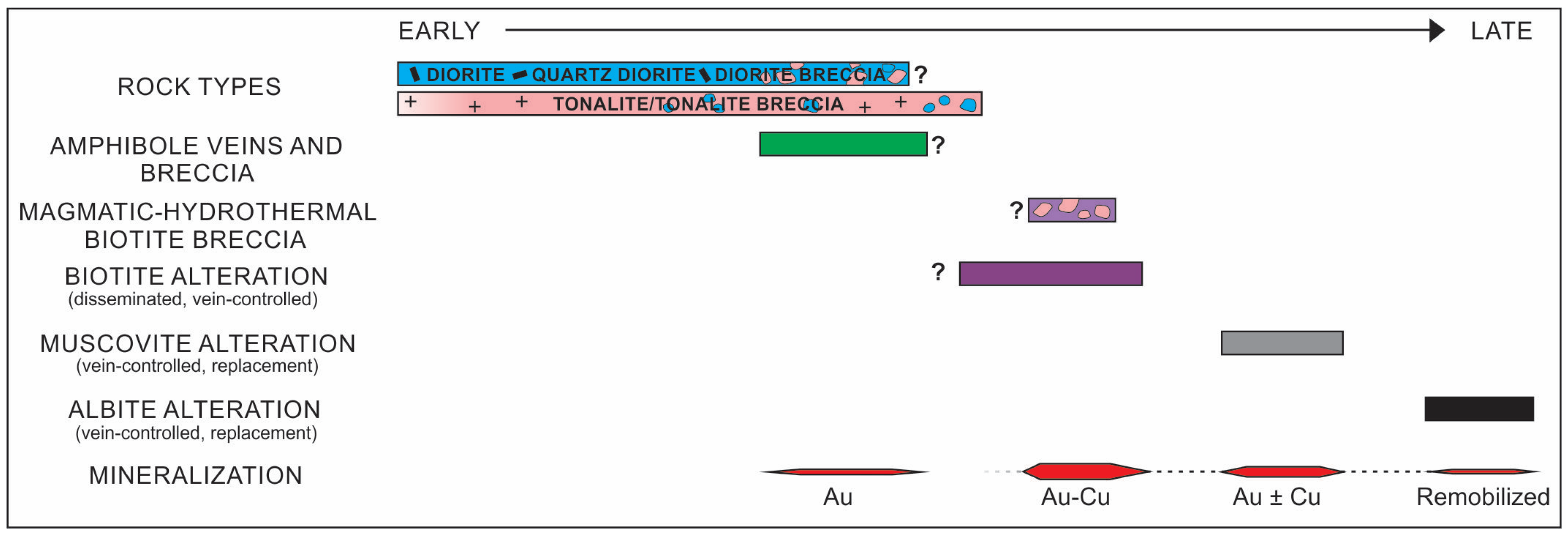
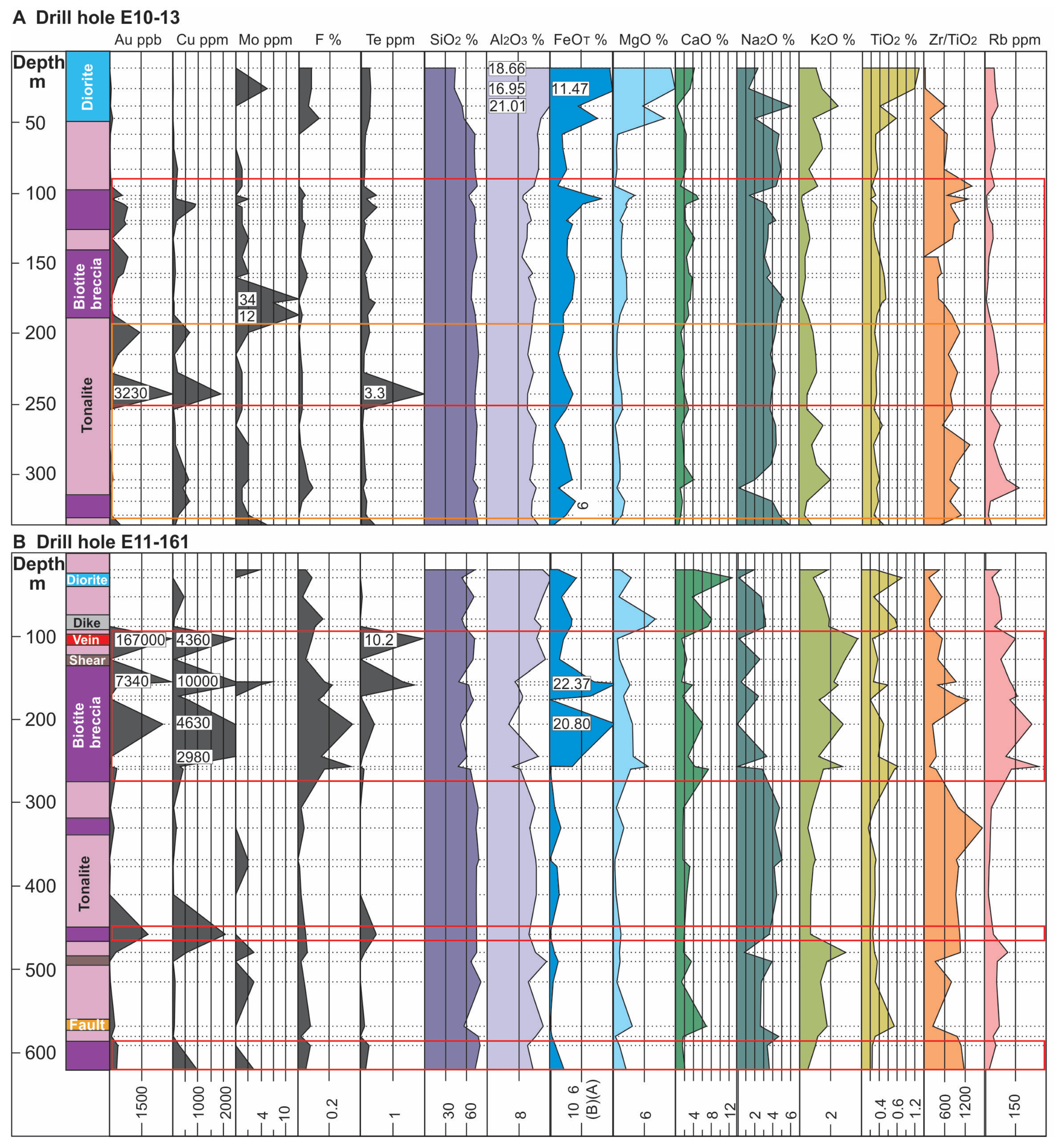

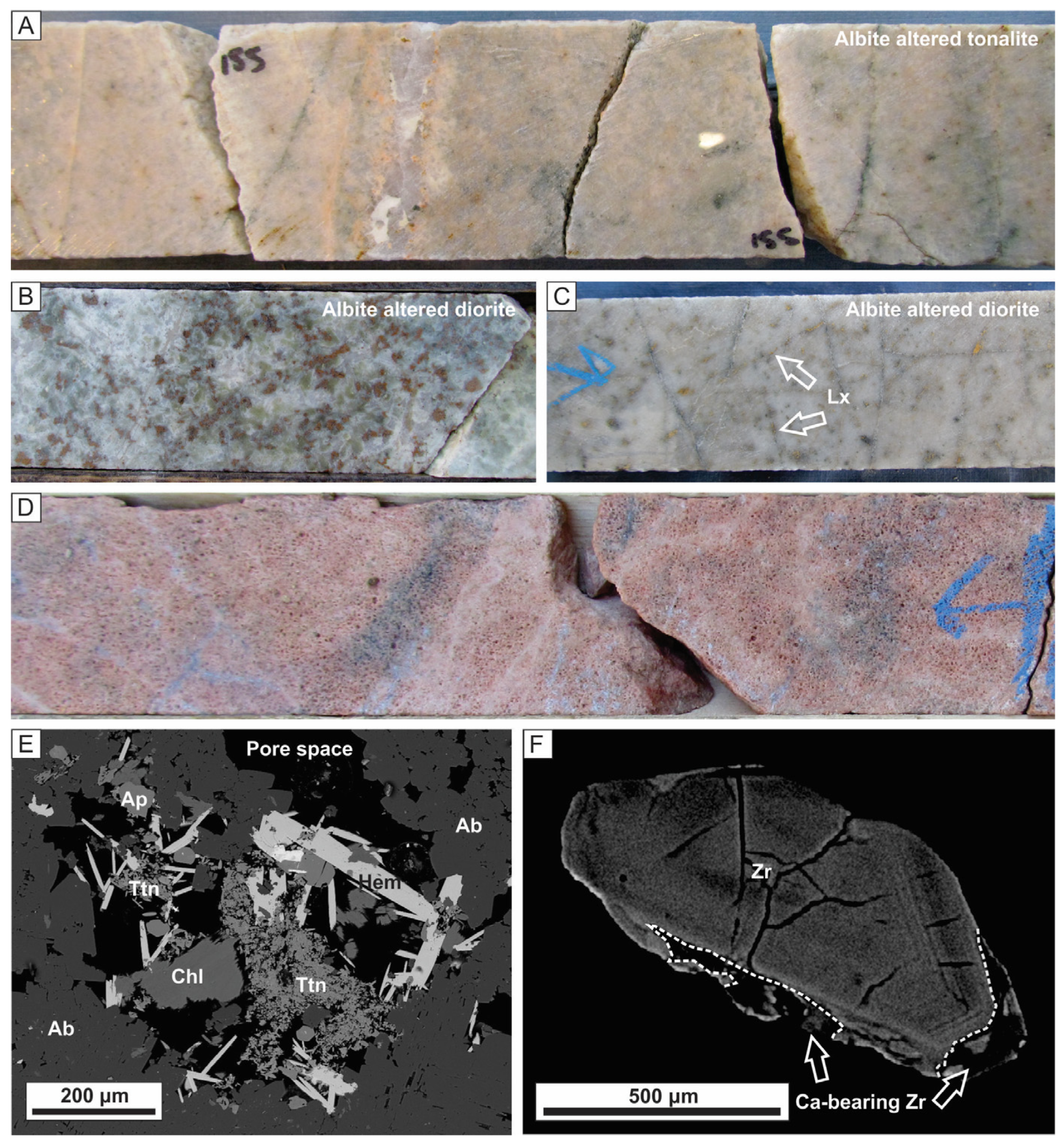
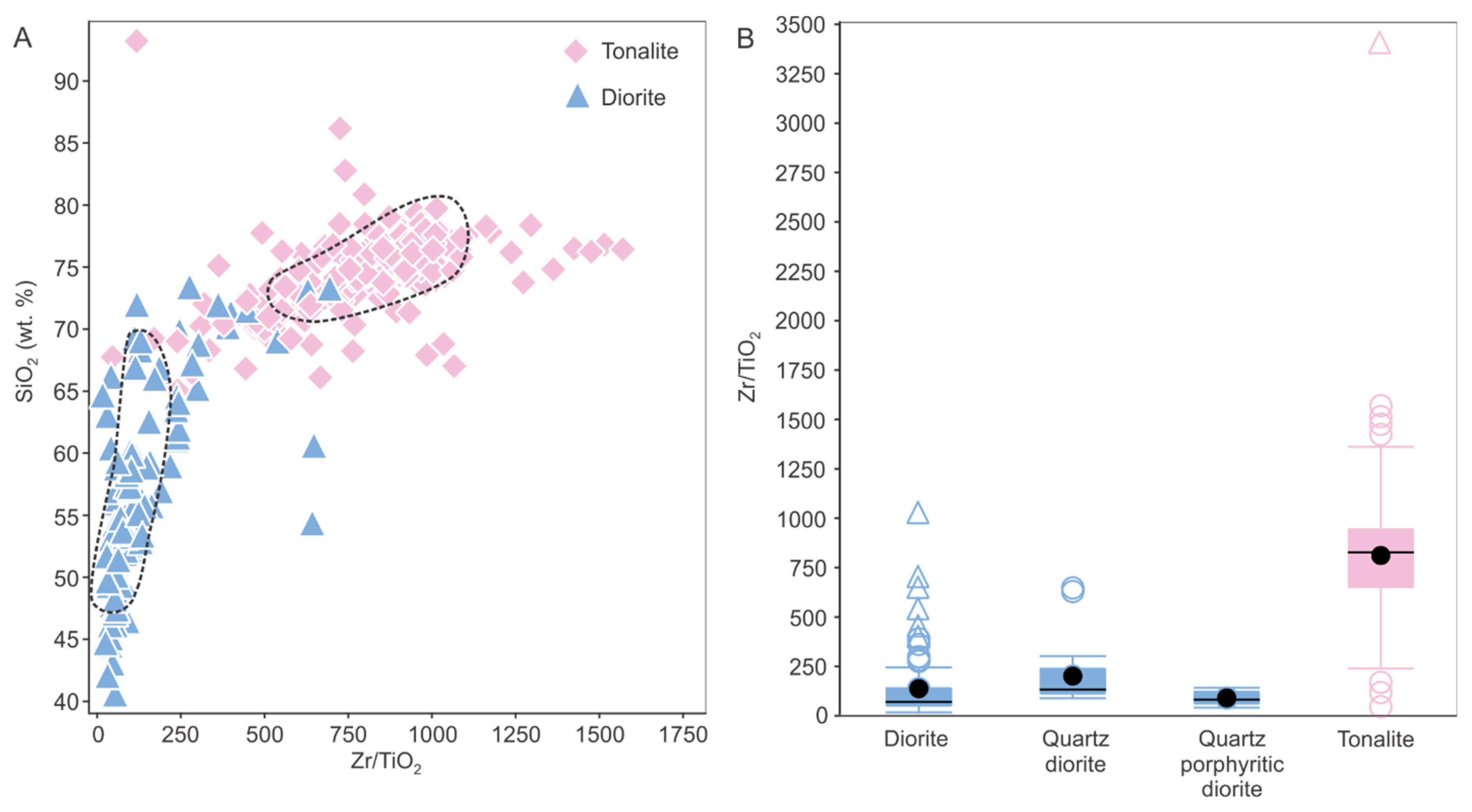

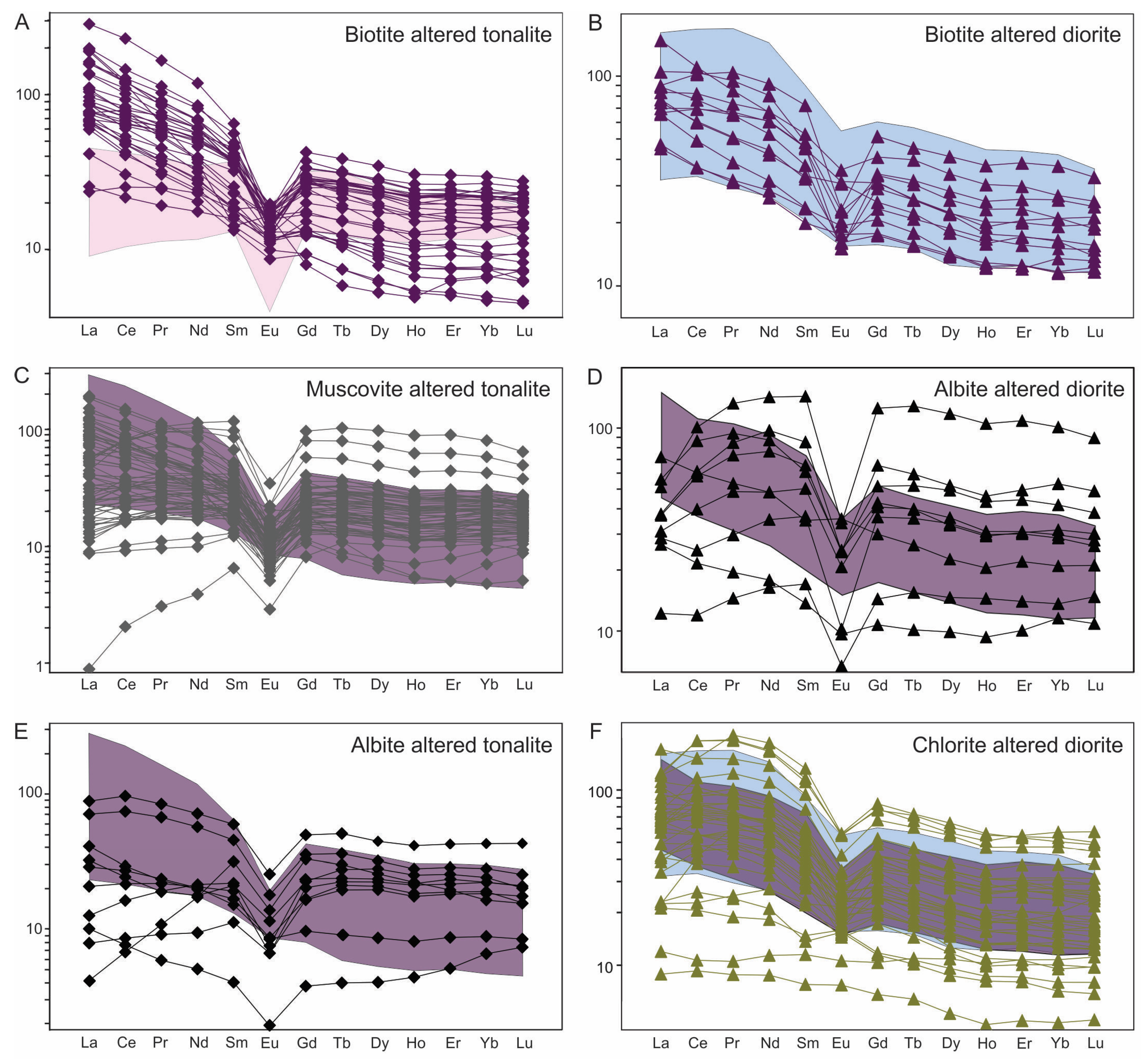
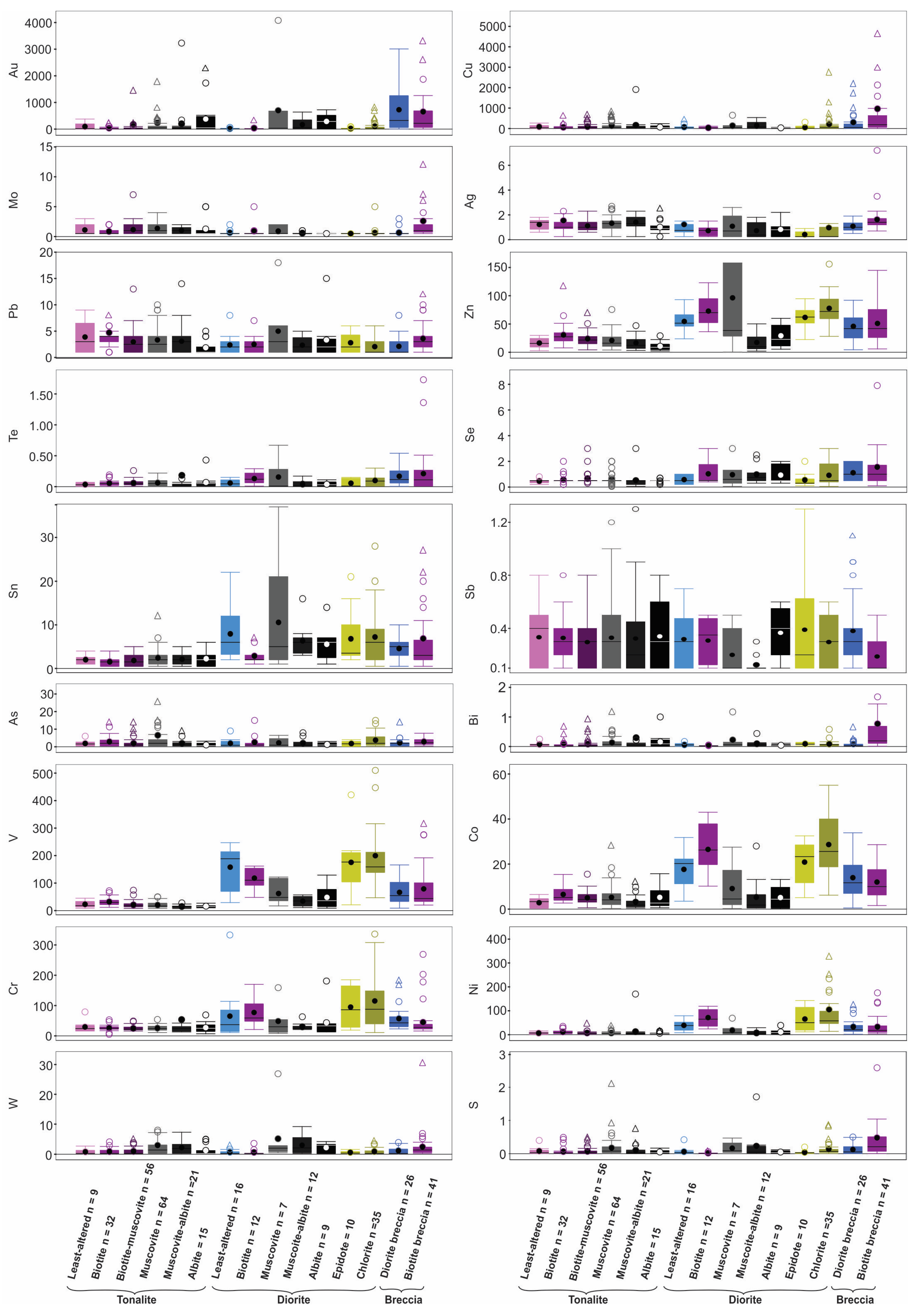
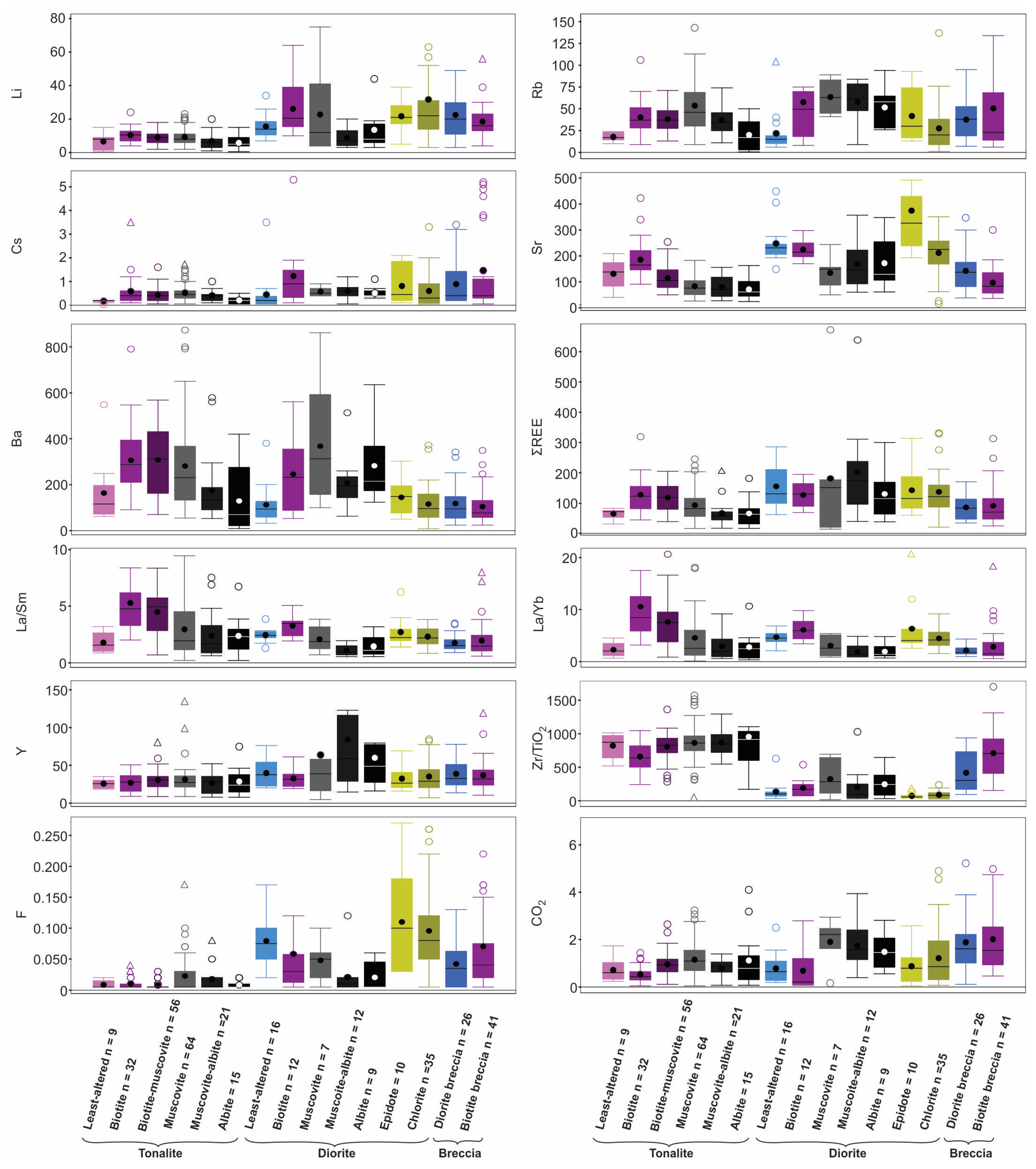

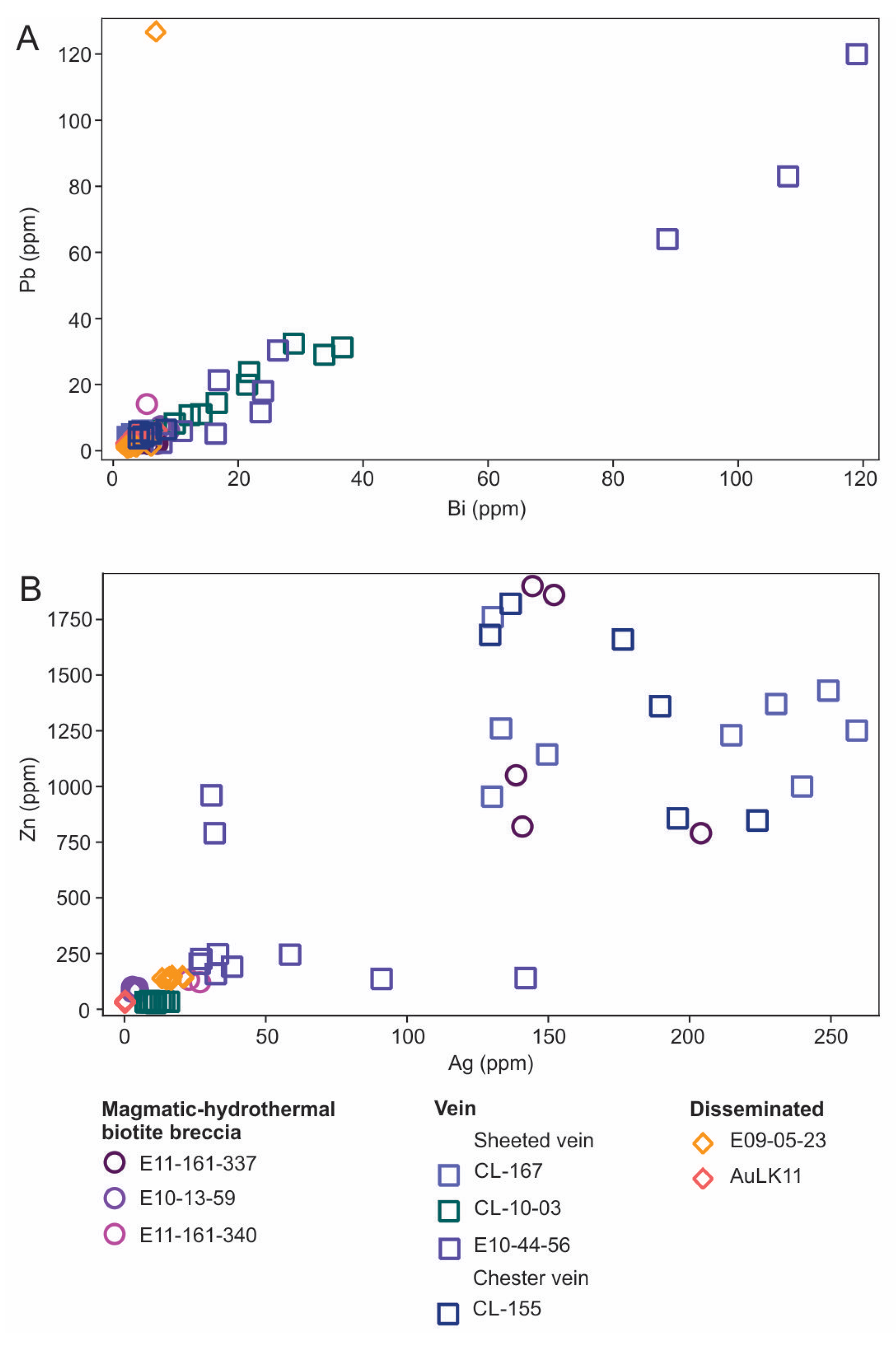
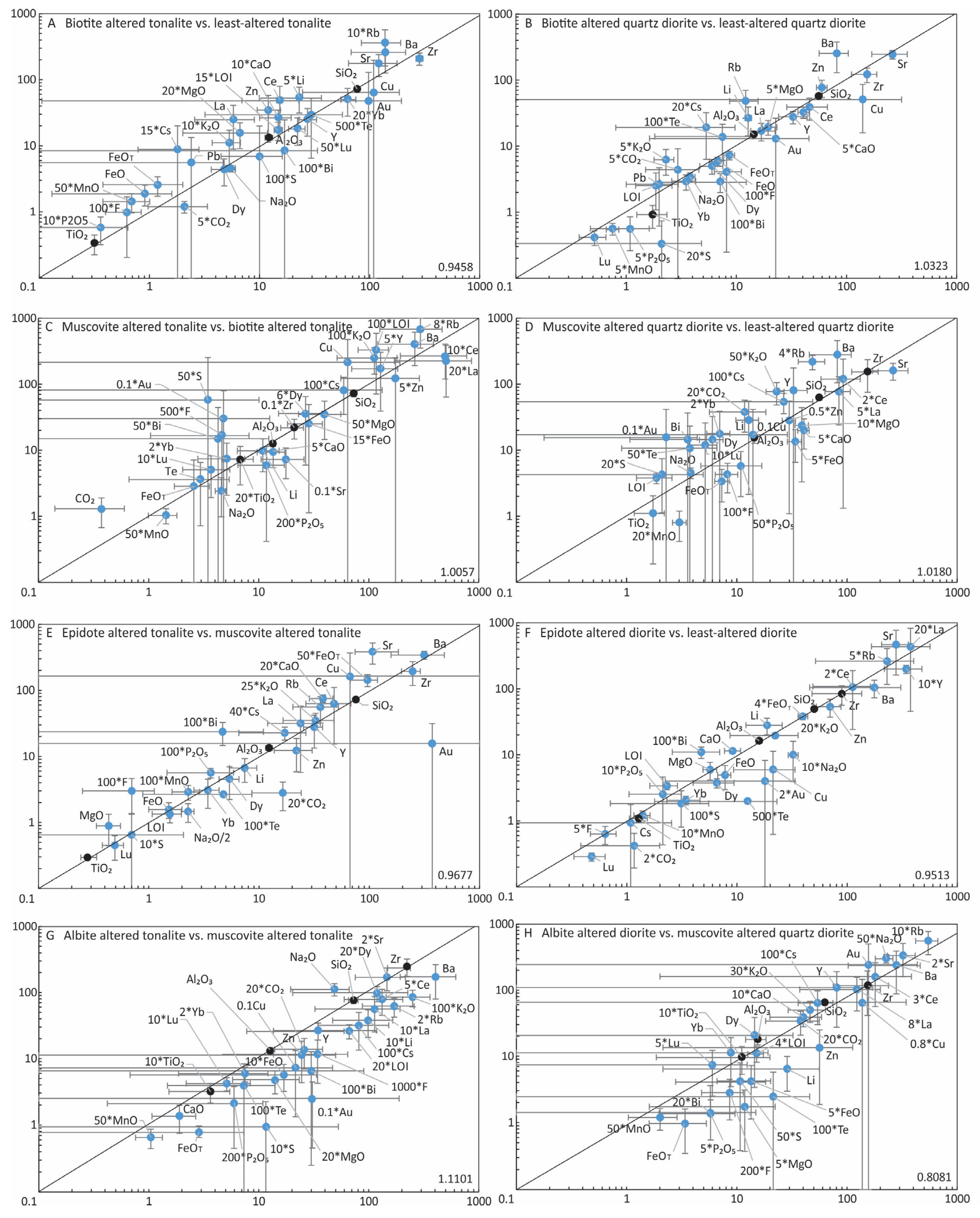

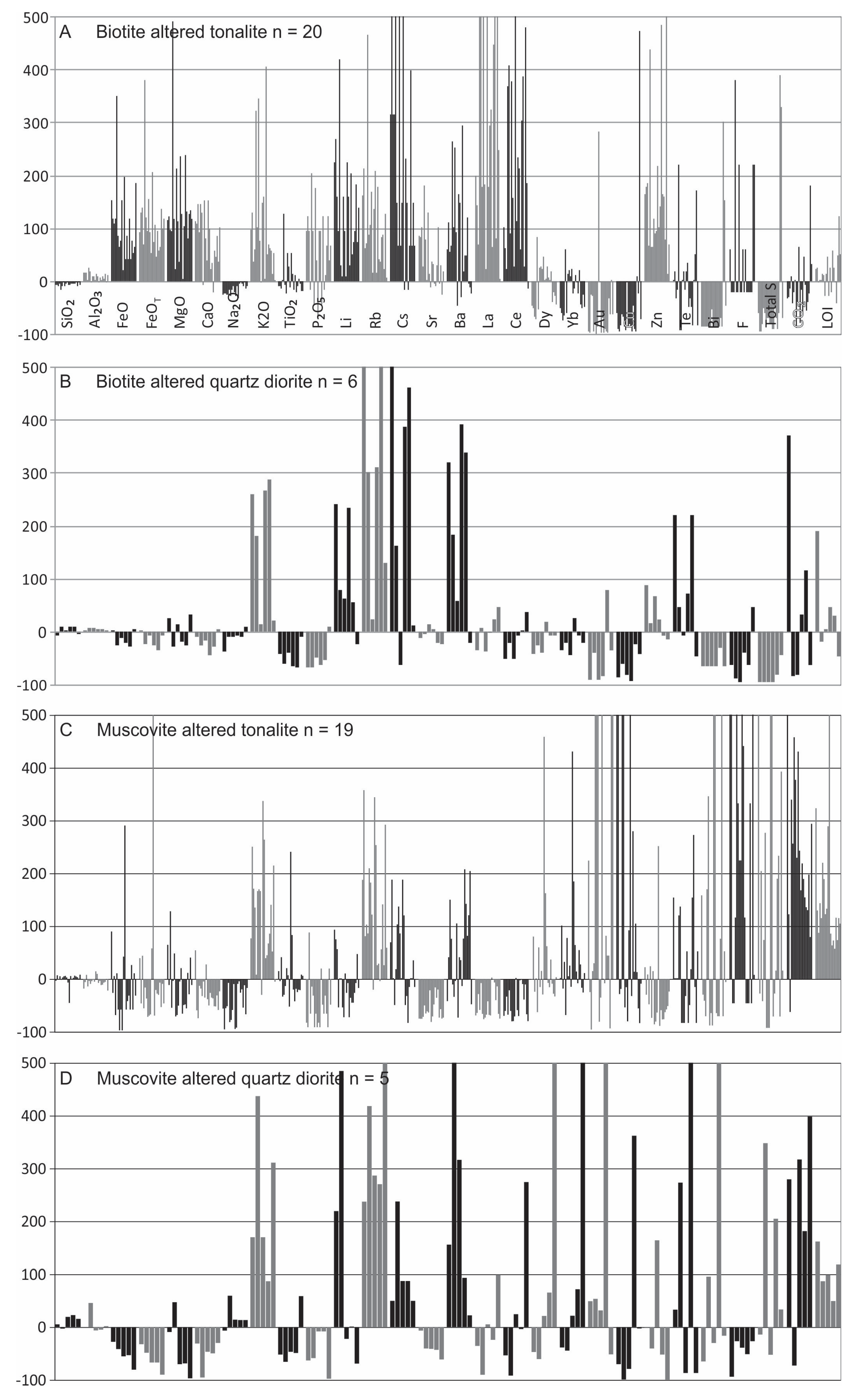
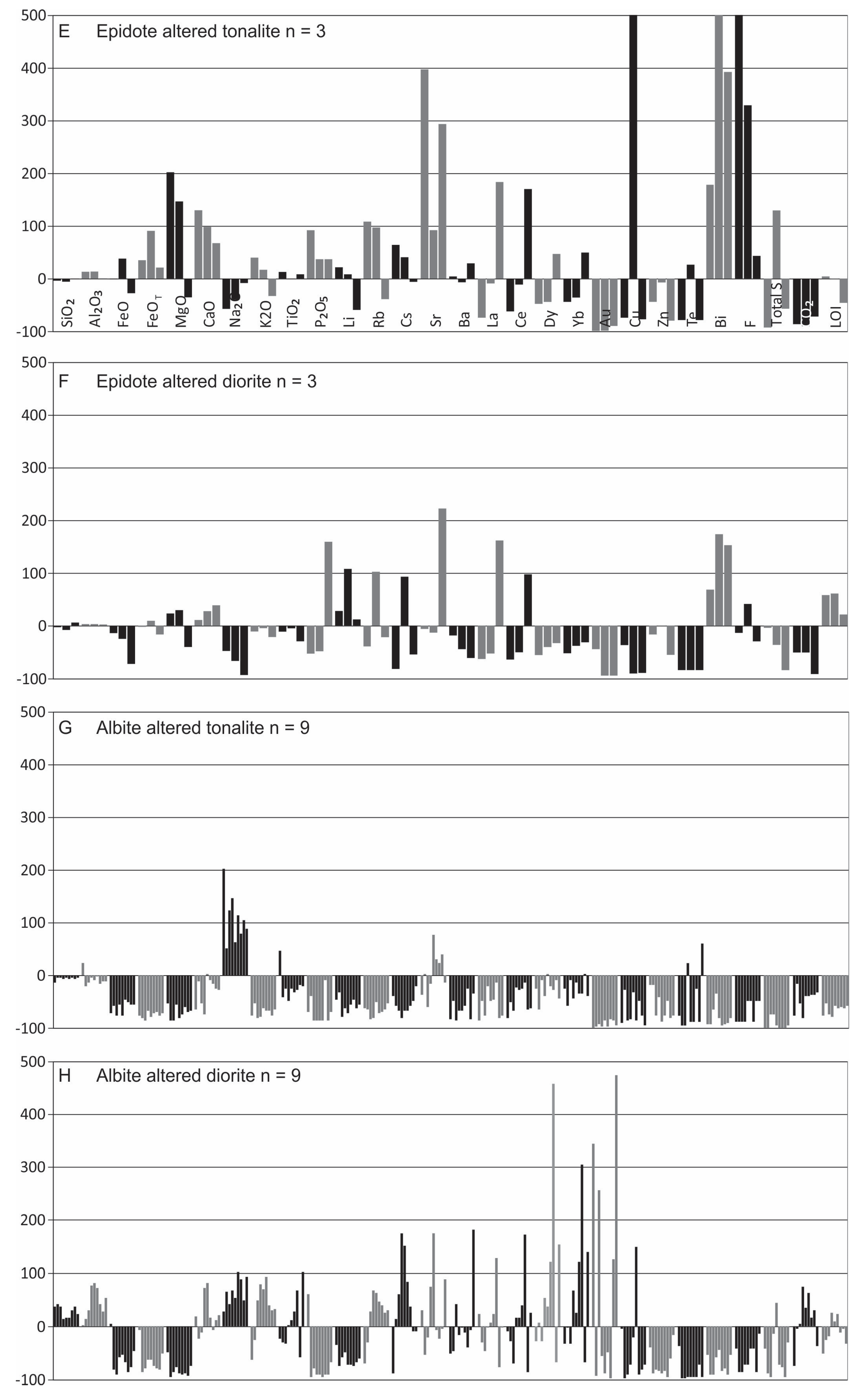

| Timing | Early (Syn-Magmatism) | Transitional to Late (Post-Magmatism) | ||||
|---|---|---|---|---|---|---|
| Alteration | Amphibole | Biotite | Muscovite | Epidote | Albite | Chlorite |
| type | (calcic) | (potassic) | (phyllic) | (sodic) | ||
| Alteration assemblage | Hbl ± Ap ± Ttn ± Mag ± Qz ± Ab ± Bt ± Py ± Ccp | Bt ± Qz ± Cal ± Ank ± Ep ± Aln ± Mag ± Ccp ± Py ± Po ± Mol ± Ap ± Bst ± Ttn ± Ilm ± Fl ± Sp ± Gn | Ms ± Qz ± Cal ± Py ± Ccp ± Po ± Chl ± Rt ± Mol ± Tur | Ep ± Qz ± Cal ± Chl | Ab ± Qz ± Cal ± Ttn ± Ilm ± Chl; Ab ± Ttn ± Hem ± Rt ± Ap ± Chl (rare) | Chl ± Qz ± Cal ± Ilm ± Rt ± Py ± Ccp |
| Vein types | Hbl ± Ab; Hbl-Ap-Ttn ± Mag ± Py ± Ccp; Hbl-Qz-Ttn ± Mag ± Py ± Ccp | Qz ± Mag ± Ccp ± Py; Bt; Qz ± Bt ± Cb ± Ccp ± Py ± Po ± Mol ± Ttn ± Aln ± Bst ± Sp ± Gn; Bt-Qz-Ep ± Mag ± Ttn ± Cb ± Fl ± Py ± Ccp | Qz-Cb ± Py ± Ccp ± Po ± Mol ± Chl ± Tur; Qz ± Cal; Ms ± Cal | Ep, Qz-Ep; Ep ± Qz ± Cal ± Chl ± Py ± Ccp | Ab ± Qz ± Cal; Ab-Ttn ± Cal; Ttn; Qz-Cal-Ilm ± Ttn; Qz-Cal-Ttn | Chl ± Qz ± Cal ± Py ± Ccp |
| Alteration style | Vein-controlled, breccias | Disseminations, vein-controlled, Breccias | Vein-controlled, Replacement | Disseminations, vein-controlled | Vein-controlled, replacement | Replacement |
| Fe | Zn | Se | Ag | Cd | In | Sn | Sb | Te | Au | Pb | Bi | ||
|---|---|---|---|---|---|---|---|---|---|---|---|---|---|
| Sample | m.d.l. | m.d.l. | m.d.l. | m.d.l. | m.d.l. | m.d.l. | m.d.l. | m.d.l. | m.d.l. | m.d.l. | m.d.l. | m.d.l. | |
| Number | 5 | 0.7 | 1.8 | 0.03 | 0.12 | 0.01 | 0.07 | 0.05 | 0.24 | 0.003 | 0.05 | 0.01 | |
| E10-13-59 | min. | 281,800 | 79.2 | 167.3 | 2.67 | 0.61 | 14.96 | 6.72 | 0.04 | n = 1 b.d.l. | 0.041 | 2.87 | 3.68 |
| Bx (n = 8) | max. | 291,500 | 100 | 190.9 | 4.85 | 0.84 | 16.23 | 21.1 | 0.22 | 0.51 | 0.258 | 7.4 | 8.94 |
| avg. | 286,200 | 87 | 179.3 | 3.49 | 0.71 | 15.58 | 17 | 0.11 | 0.17 | 0.142 | 5.1 | 6.3 | |
| STD | 3791 | 8 | 8.9 | 0.86 | 0.07 | 0.43 | 5 | 0.06 | 0.16 | 0.066 | 1.4 | 1.9 | |
| E11-161- | min. | 284,900 | 790 | 136.2 | 138.6 | 21.1 | 19.55 | 48.5 | 0.03 | 0.24 | 0.006 | 1.98 | 4.35 |
| 337 | max. | 291,600 | 1900 | 141.3 | 204 | 47.9 | 20.23 | 114 | 0.05 | 0.41 | 0.023 | 2.36 | 7.09 |
| Bx (n = 5) | avg. | 288,220 | 1284 | 123.6 | 156 | 33.2 | 19.78 | 82 | 0.04 | 0.34 | 0.013 | 2.11 | 5.92 |
| STD | 2895 | 495 | 25.4 | 24 | 11.8 | 0.25 | 26 | 0.01 | 0.06 | 0.006 | 0.14 | 0.96 | |
| E11-161- | min. | 291,400 | 121 | 82.7 | 22.79 | 3.71 | 99.4 | 13.63 | 0.37 | b.d.l. | 0.004 | 9.46 | 1.7 |
| 340 | max. | 295,700 | 132.6 | 84.2 | 26.7 | 5.48 | 100.3 | 20.9 | 0.52 | b.d.l. | 0.017 | 14.1 | 5.4 |
| Bx (n = 2) | avg. | 293,550 | 127 | 83.5 | 24.7 | 4.60 | 99.9 | 17.3 | 0.44 | b.d.l. | 0.011 | 11.8 | 3.6 |
| STD | 2150 | 6 | 0.8 | 2.0 | 0.88 | 0.4 | 3.6 | 0.08 | b.d.l. | 0.006 | 2.3 | 1.9 | |
| CL-10-03 | min. | 272,000 | 27.81 | 85.6 | 7.5 | 0.45 | 26.84 | 5.63 | 0.04 | 0.25 | 0.091 | 6 | 6.2 |
| Vn (n = 10) | max. | 288,900 | 37.1 | 98.6 | 15.73 | 0.83 | 29.45 | 70 | 0.21 | 2.27 | 0.973 | 32.4 | 36.7 |
| avg. | 281,610 | 33.3 | 92 | 10.8 | 0.6 | 28.0 | 16 | 0.13 | 1.23 | 0.484 | 19 | 20.2 | |
| STD | 5299 | 2.6 | 4 | 2.6 | 0.1 | 0.7 | 20 | 0.06 | 0.66 | 0.291 | 9 | 9.8 | |
| CL-167 | min. | 296,100 | 954 | 100.9 | 130.1 | 15.19 | 6.6 | 18.48 | 0.21 | 0.67 | 0.119 | 3 | 2.33 |
| SVn (n = 9) | max. | 312,000 | 1760 | 157.9 | 259.2 | 29.2 | 8.32 | 26.54 | 0.60 | 1.48 | 0.293 | 6.07 | 4.72 |
| avg. | 307,644 | 1267 | 123 | 193.0 | 20 | 7.3 | 21.4 | 0.32 | 0.95 | 0.2 | 4 | 3.10 | |
| STD | 5401 | 228 | 22 | 52.6 | 4 | 0.6 | 3.0 | 0.11 | 0.22 | 0.1 | 1 | 0.67 | |
| AuLk11 | min. | 270,800 | 29.2 | 91.6 | 0.13 | 0.46 | 2.94 | 0.72 | 0.07 | n = 7 b.d.l. | 0.107 | 2.4 | 1.91 |
| Diss (n = 10) | max. | 282,900 | 36.7 | 178 | 0.33 | 1.17 | 3.28 | 1.1 | 0.36 | 1.27 | 0.71 | 6.48 | 6.91 |
| avg. | 276,490 | 32 | 152 | 0.21 | 0.84 | 3.1 | 0.9 | 0.20 | 0.74 | 0.3 | 4.5 | 3.82 | |
| STD | 3775 | 2 | 23 | 0.06 | 0.18 | 0.1 | 0.1 | 0.10 | 0.29 | 0.2 | 1.3 | 1.30 | |
| E10-44-56 | min. | 275,700 | 136 | 38.7 | 26.6 | 1.48 | 14.33 | 10.84 | 0.13 | n = 4 b.d.l. | 0.317 | 2.32 | 7.74 |
| SVn (n = 10) | max. | 291,000 | 960 | 61.9 | 142 | 8.3 | 27.47 | 14.2 | 0.81 | 4.1 | 17.2 | 120 | 119 |
| avg. | 282,980 | 330 | 54 | 51 | 2.9 | 20.0 | 12.1 | 0.41 | 1.4 | 4 | 36 | 44 | |
| STD | 3989 | 278 | 7 | 36 | 2.0 | 4.9 | 1.0 | 0.25 | 1.2 | 5 | 38 | 41 | |
| E09-05-23 | min. | 280,300 | 131.5 | 195.8 | 13.31 | 1.65 | 16.8 | 28.81 | 0.05 | 1 | 0.112 | 1 | 1.94 |
| Diss (n = 10) | max. | 292,600 | 148.7 | 214.8 | 20.96 | 2.25 | 18.17 | 52.1 | 0.66 | 6.8 | 2.05 | 127 | 6.69 |
| avg. | 288,000 | 140 | 205 | 16.7 | 2.04 | 17.7 | 40.8 | 0.14 | 4 | 0.44 | 14 | 3.4 | |
| STD | 3463 | 5 | 6 | 2.3 | 0.16 | 0.4 | 7.8 | 0.18 | 2 | 0.54 | 38 | 1.5 | |
| CL-155 | min. | 297,500 | 847 | 30.4 | 129.4 | 12.53 | 5.025 | 15.49 | 0.12 | 0.77 | 0.056 | 3.71 | 4.07 |
| CVn (n = 6) | max. | 317,200 | 1820 | 32.4 | 224 | 18.0 | 6.418 | 19.54 | 0.27 | 2.67 | 0.121 | 6.38 | 8.52 |
| avg. | 309,183 | 1371 | 31.1 | 175 | 16 | 5.7 | 16.89 | 0.19 | 1.53 | 0.096 | 5.1 | 5.62 | |
| STD | 6397 | 391 | 0.8 | 33 | 2 | 0.5 | 1.48 | 0.05 | 0.64 | 0.021 | 0.9 | 1.52 |
| Tonalite | ||||||||||||||||||
| Least-Altered | Disseminated/Stockwork Biotite | Fracture-ControlledSericite | Pervasive Sericite | Disseminated/Fracture-Controlled Epidote | Pervasive Albite | |||||||||||||
| Average | STD | No. | Average | STD | No. | Average | STD | No. | Average | STD | No. | Average | STD | No. | Average | STD | No. | |
| SiO2 | 77.052 | 2.0795 | 5 | 72.58 | 2.45 | 20 | 75.30 | 1.94 | 20 | 72.77 | 8.21 | 19 | 72.623 | 1.51 | 3 | 76.122 | 2.6468 | 9 |
| Al2O3 | 12.206 | 0.58 | 5 | 13.38 | 0.89 | 20 | 12.30 | 0.69 | 20 | 12.68 | 1.17 | 19 | 13.407 | 0.75 | 3 | 13.042 | 1.6771 | 9 |
| FeO | 0.91 | 0.78 | 5 | 1.90 | 0.67 | 20 | 1.52 | 0.49 | 20 | 1.69 | 1.61 | 19 | 1.57 | 0.41 | 3 | 0.57 | 0.25 | 9 |
| Fe2O3 | 1.32 | 0.90 | 5 | 1.89 | 0.67 | 20 | 0.45 | 0.38 | 20 | 1.31 | 3.15 | 19 | 1.37 | 0.24 | 3 | 0.24 | 0.20 | 9 |
| FeOT | 1.19 | 0.81 | 5 | 2.58 | 0.85 | 20 | 1.92 | 0.57 | 20 | 1.17 | 2.83 | 19 | 1.23 | 0.22 | 3 | 0.22 | 0.18 | 9 |
| MnO | 0.0138 | 0.0062 | 5 | 0.029 | 0.009 | 20 | 0.023 | 0.007 | 20 | 0.021 | 0.005 | 19 | 0.029 | 0.0073 | 3 | 0.0131 | 0.0042 | 9 |
| MgO | 0.33 | 0.23 | 5 | 0.79 | 0.33 | 20 | 0.43 | 0.11 | 20 | 0.70 | 0.41 | 19 | 0.89 | 0.44 | 3 | 0.24 | 0.09 | 9 |
| CaO | 1.48 | 0.50 | 5 | 2.70 | 0.77 | 20 | 1.90 | 0.49 | 20 | 1.90 | 0.80 | 19 | 3.76 | 0.49 | 3 | 1.37 | 0.62 | 9 |
| Na2O | 5.44 | 0.51 | 5 | 4.57 | 0.52 | 20 | 4.54 | 0.53 | 20 | 2.44 | 1.45 | 19 | 2.93 | 0.92 | 3 | 5.63 | 1.18 | 9 |
| K2O | 0.53 | 0.16 | 5 | 1.12 | 0.61 | 20 | 1.30 | 0.64 | 20 | 2.50 | 1.08 | 19 | 1.40 | 0.40 | 3 | 0.85 | 0.24 | 9 |
| TiO2 | 0.317 | 0.026 | 5 | 0.339 | 0.111 | 20 | 0.278 | 0.049 | 20 | 0.363 | 0.213 | 19 | 0.2963 | 0.0159 | 3 | 0.3164 | 0.103 | 9 |
| P2O5 | 0.04 | 0.03 | 5 | 0.06 | 0.03 | 20 | 0.04 | 0.02 | 20 | 0.03 | 0.03 | 19 | 0.06 | 0.01 | 3 | 0.01 | 0.01 | 9 |
| LOI | 0.99 | 0.16 | 5 | 1.16 | 0.36 | 20 | 1.56 | 0.44 | 20 | 3.32 | 2.61 | 19 | 1.34 | 0.35 | 3 | 1.31 | 0.32 | 9 |
| Total | 99.71 | 0.56 | 5 | 99.57 | 0.73 | 20 | 99.79 | 0.98 | 20 | 99.89 | 1.03 | 19 | 99.90 | 0.52 | 3 | 99.73 | 0.68 | 9 |
| Total S | 0.10 | 0.06 | 5 | 0.07 | 0.13 | 20 | 0.07 | 0.14 | 20 | 1.17 | 3.95 | 19 | 0.07 | 0.07 | 3 | 0.09 | 0.13 | 9 |
| CO2 | 0.42 | 0.23 | 5 | 0.37 | 0.24 | 20 | 0.82 | 0.38 | 20 | 1.29 | 0.62 | 19 | 0.14 | 0.06 | 3 | 0.68 | 0.3319 | 9 |
| F | 0.0063 | 0.0022 | 5 | 0.009 | 0.007 | 20 | 0.007 | 0.005 | 20 | 0.034 | 0.029 | 19 | 0.030 | 0.0163 | 3 | 0.0117 | 0.0075 | 9 |
| Au | 98 | 110 | 5 | 48 | 82 | 20 | 371 | 1519 | 20 | 304 | 492 | 19 | 16 | 16 | 3 | 24 | 20 | 9 |
| Cu | 109.0 | 89.6 | 5 | 64.0 | 133.3 | 20 | 66.7 | 107.8 | 20 | 215.6 | 261.2 | 19 | 162.1 | 206.41 | 3 | 72.8 | 59.6 | 9 |
| Mo | 0.8 | 0.6 | 5 | 0.7 | 0.4 | 20 | 1.2 | 0.7 | 20 | 1.5 | 1.0 | 19 | 3.0 | 0.8 | 3 | 1.0 | 0.6 | 9 |
| Ag | 1.2 | 0.4 | 5 | 1.0 | 0.3 | 20 | 1.2 | 0.4 | 20 | 1.2 | 0.6 | 19 | 1.2 | 0.6377 | 3 | 1.2 | 0.5 | 9 |
| Sb | 0.4 | 0.3 | 5 | 0.4 | 0.2 | 20 | 0.3 | 0.2 | 20 | 0.3 | 0.3 | 19 | 0.2 | 0.1 | 3 | 0.3 | 0.3 | 9 |
| Te | 0.059 | 0.0528 | 5 | 0.059 | 0.046 | 20 | 0.048 | 0.039 | 20 | 0.073 | 0.059 | 19 | 0.027 | 0.024 | 3 | 0.0389 | 0.0443 | 9 |
| Bi | 0.17 | 0.17 | 5 | 0.09 | 0.16 | 20 | 0.05 | 0.06 | 20 | 0.30 | 0.59 | 19 | 0.24 | 0.09 | 3 | 0.07 | 0.06 | 9 |
| Se | 0.5 | 0.0 | 5 | 0.7 | 0.4 | 20 | 0.7 | 0.4 | 20 | 0.7 | 0.6 | 19 | 0.3 | 0.2 | 3 | 0.4 | 0.1 | 9 |
| As | 2.4 | 2.0 | 5 | 3.4 | 3.5 | 20 | 1.6 | 1.5 | 20 | 16.9 | 38.7 | 19 | 2.1 | 1.8 | 3 | 1.4 | 1.4 | 9 |
| Pb | 2 | 2 | 5 | 6 | 8 | 20 | 3 | 2 | 20 | 7 | 11 | 19 | 3 | 2 | 3 | 2 | 1 | 9 |
| W | 0.86 | 1.06 | 5 | 0.77 | 1.07 | 20 | 0.61 | 0.79 | 20 | 7.26 | 15.04 | 19 | 0.40 | 0.21 | 3 | 1.64 | 1.36 | 9 |
| Zn | 12.0 | 2.4 | 5 | 34.7 | 23.4 | 20 | 21.8 | 8.2 | 20 | 24.5 | 26.2 | 19 | 12.3 | 6.5 | 3 | 11.3 | 7.0 | 9 |
| Li | 5 | 3 | 5 | 11 | 5 | 20 | 7 | 2 | 20 | 10 | 5 | 19 | 7 | 3 | 3 | 4 | 2 | 9 |
| Rb | 14 | 6 | 5 | 37 | 20 | 20 | 36 | 16 | 20 | 85 | 41 | 19 | 56 | 24 | 3 | 31 | 10 | 9 |
| Cs | 0.1 | 0.1 | 5 | 0.6 | 0.7 | 20 | 0.4 | 0.3 | 20 | 0.8 | 0.5 | 19 | 0.6 | 0.1 | 3 | 0.3 | 0.2 | 9 |
| Sr | 121 | 60 | 5 | 176 | 65 | 20 | 107 | 34 | 20 | 73 | 36 | 19 | 385 | 135 | 3 | 86 | 32 | 9 |
| Ba | 139 | 69 | 5 | 260 | 133 | 20 | 314 | 164 | 20 | 405 | 213 | 19 | 342 | 47 | 3 | 172 | 93 | 9 |
| V | 14 | 5 | 5 | 32 | 15 | 20 | 17 | 6 | 20 | 22 | 11 | 19 | 31 | 10 | 3 | 13 | 3 | 9 |
| Y | 27.2 | 5.8 | 5 | 25.4 | 11.4 | 20 | 31.6 | 7.5 | 20 | 34.6 | 26.7 | 19 | 27.8 | 14.4 | 3 | 26.7 | 7.6 | 9 |
| Zr | 284 | 25 | 5 | 210 | 44 | 20 | 247 | 50 | 20 | 222 | 74 | 19 | 194 | 76 | 3 | 248 | 73 | 9 |
| La | 5.8 | 3.3 | 5 | 25.1 | 16.1 | 20 | 23.8 | 12.2 | 20 | 11.3 | 8.1 | 19 | 31.7 | 26.0 | 3 | 5.6 | 3.1 | 9 |
| Ce | 15.3 | 7.5 | 5 | 49.1 | 30.7 | 20 | 47.8 | 21.6 | 20 | 26.4 | 14.4 | 19 | 63.1 | 47.6 | 3 | 15.8 | 6.7 | 9 |
| Dy | 4.78 | 1.15 | 5 | 4.42 | 1.94 | 20 | 5.39 | 1.24 | 20 | 5.94 | 4.94 | 19 | 4.58 | 2.36 | 3 | 4.88 | 1.27 | 9 |
| Yb | 3.16 | 0.58 | 5 | 2.56 | 1.15 | 20 | 3.44 | 0.78 | 20 | 3.75 | 2.70 | 19 | 3.08 | 1.45 | 3 | 2.97 | 0.74 | 9 |
| Lu | 0.4434 | 0.0742 | 5 | 0.368 | 0.164 | 20 | 0.492 | 0.104 | 20 | 0.510 | 0.317 | 19 | 0.45 | 0.1821 | 3 | 0.4183 | 0.0958 | 9 |
| Quartz diorite | Diorite | ||||||||||||||||||||
|---|---|---|---|---|---|---|---|---|---|---|---|---|---|---|---|---|---|---|---|---|---|
| Least-Altered | Disseminated Biotite | Fracture-Controlled/ | Pervasive Albite | Disseminated Chlorite | Least-Altered | Pervasive Epidote | |||||||||||||||
| Pervasive Sericite | |||||||||||||||||||||
| Average | STD | No. | Average | STD | No. | Average | STD | No. | Average | STD | No. | Average | STD | No. | Average | STD | No. | Average | STD | No. | |
| SiO2 | 55.97 | 2.14 | 6 | 57.74 | 3.90 | 6 | 62.76 | 5.33 | 5 | 65.22 | 5.16 | 9 | 55.02 | 1.39 | 6 | 50.33 | 1.36 | 4 | 49.52 | 2.97 | 3 |
| Al2O3 | 14.44 | 0.51 | 6 | 15.14 | 0.30 | 6 | 15.46 | 2.81 | 5 | 18.07 | 3.33 | 9 | 14.32 | 0.96 | 6 | 15.91 | 1.43 | 4 | 16.33 | 0.05 | 3 |
| FeO | 6.80 | 0.99 | 6 | 5.93 | 0.87 | 6 | 2.70 | 1.39 | 5 | 0.83 | 0.61 | 9 | 6.32 | 1.30 | 6 | 7.80 | 1.04 | 4 | 4.93 | 1.96 | 3 |
| Fe2O3 | 2.09 | 0.92 | 6 | 1.53 | 0.48 | 6 | 0.77 | 0.45 | 5 | 0.15 | 0.15 | 9 | 2.57 | 0.84 | 6 | 2.31 | 0.47 | 4 | 5.13 | 1.48 | 3 |
| FeOT | 1.88 | 0.83 | 6 | 1.37 | 0.43 | 6 | 0.69 | 0.40 | 5 | 0.14 | 0.14 | 9 | 2.31 | 0.76 | 6 | 2.07 | 0.42 | 4 | 9.55 | 1.01 | 3 |
| MnO | 0.151 | 0.022 | 6 | 0.1128 | 0.023 | 6 | 0.040 | 0.020 | 5 | 0.0239 | 0.0085 | 9 | 0.130 | 0.058 | 6 | 0.140 | 0.025 | 4 | 0.1207 | 0.0205 | 3 |
| MgO | 3.90 | 0.60 | 6 | 3.92 | 0.98 | 6 | 2.36 | 2.03 | 5 | 0.34 | 0.27 | 9 | 4.16 | 1.16 | 6 | 5.71 | 0.74 | 4 | 5.94 | 1.78 | 3 |
| CaO | 8.15 | 0.80 | 6 | 6.55 | 1.26 | 6 | 4.02 | 1.94 | 5 | 3.89 | 1.09 | 9 | 6.58 | 1.41 | 6 | 9.14 | 1.28 | 4 | 11.46 | 1.04 | 3 |
| Na2O | 3.81 | 0.31 | 6 | 3.43 | 0.52 | 6 | 4.53 | 0.83 | 5 | 6.06 | 0.87 | 9 | 4.18 | 0.54 | 6 | 3.24 | 0.33 | 4 | 1.00 | 0.61 | 3 |
| K2O | 0.46 | 0.09 | 6 | 1.25 | 0.52 | 6 | 1.54 | 0.57 | 5 | 1.67 | 0.59 | 9 | 0.57 | 0.27 | 6 | 1.11 | 0.67 | 4 | 0.98 | 0.07 | 3 |
| TiO2 | 1.741 | 0.535 | 6 | 0.9192 | 0.3483 | 6 | 1.1106 | 0.9215 | 5 | 0.969 | 0.4382 | 9 | 1.4067 | 0.1507 | 6 | 1.2853 | 0.2233 | 4 | 1.0883 | 0.1304 | 3 |
| P2O5 | 0.22 | 0.12 | 6 | 0.11 | 0.06 | 6 | 0.12 | 0.08 | 5 | 0.03 | 0.04 | 9 | 0.31 | 0.13 | 6 | 0.21 | 0.11 | 4 | 0.25 | 0.21 | 3 |
| LOI | 1.87 | 0.63 | 6 | 2.51 | 1.43 | 6 | 3.79 | 0.69 | 5 | 2.77 | 0.75 | 9 | 3.76 | 1.47 | 6 | 2.31 | 0.64 | 4 | 3.39 | 0.42 | 3 |
| Total | 100.34 | 0.38 | 6 | 99.81 | 0.59 | 6 | 99.49 | 0.32 | 5 | 100.06 | 0.81 | 9 | 100.01 | 0.58 | 6 | 100.36 | 0.43 | 4 | 100.70 | 0.22 | 3 |
| Total S | 0.11 | 0.14 | 6 | 0.02 | 0.02 | 6 | 0.21 | 0.16 | 5 | 0.08 | 0.08 | 9 | 0.23 | 0.29 | 6 | 0.03 | 0.02 | 4 | 0.02 | 0.01 | 3 |
| CO2 | 0.59 | 0.31 | 6 | 0.88 | 0.95 | 6 | 1.89 | 0.96 | 5 | 1.72 | 0.68 | 9 | 1.76 | 1.10 | 6 | 0.59 | 0.39 | 4 | 0.21 | 0.11 | 3 |
| F | 0.082 | 0.020 | 6 | 0.0408 | 0.0383 | 6 | 0.043 | 0.020 | 5 | 0.0139 | 0.0084 | 9 | 0.0533 | 0.0125 | 6 | 0.1275 | 0.0327 | 4 | 0.1267 | 0.0386 | 3 |
| Au | 23 | 21 | 6 | 13 | 14 | 6 | 157 | 258 | 5 | 241 | 260 | 9 | 82 | 125 | 6 | 9 | 8 | 4 | 2 | 2 | 3 |
| Cu | 140.4 | 148.6 | 6 | 51.233 | 35.205 | 6 | 171.7 | 243.0 | 5 | 80.3 | 102.6 | 9 | 202.0 | 247.6 | 6 | 21.3 | 12.1 | 4 | 6.0 | 5.4 | 3 |
| Mo | 0.6 | 0.2 | 6 | 1.3 | 1.7 | 6 | 1.1 | 0.7 | 5 | 0.5 | 0.0 | 9 | 0.5 | 0.0 | 6 | 0.6 | 0.2 | 4 | 0.5 | 0 | 3 |
| Ag | 0.7 | 0.2 | 6 | 0.6 | 0.3 | 6 | 1.0 | 0.6 | 5 | 0.6 | 0.5 | 9 | 0.8 | 0.4 | 6 | 2.2 | 3.2 | 4 | 0.4 | 0.2 | 3 |
| Sb | 0.5 | 0.2 | 6 | 0.4 | 0.1 | 6 | 0.2 | 0.2 | 5 | 0.2 | 0.2 | 9 | 0.4 | 0.1 | 6 | 0.2 | 0.1 | 4 | 0.1 | 0.0 | 3 |
| Te | 0.075 | 0.057 | 6 | 0.1383 | 0.0773 | 6 | 0.214 | 0.2484 | 5 | 0.0244 | 0.033 | 9 | 0.1217 | 0.0279 | 6 | 0.0475 | 0.0225 | 4 | 0.01 | 0.00 | 3 |
| Bi | 0.07 | 0.05 | 6 | 0.03 | 0.01 | 6 | 0.29 | 0.44 | 5 | 0.07 | 0.04 | 9 | 0.05 | 0.03 | 6 | 0.05 | 0.02 | 4 | 0.11 | 0.02 | 3 |
| Se | 0.6 | 0.3 | 6 | 1.1 | 0.7 | 6 | 1.2 | 1.0 | 5 | 1.1 | 0.6 | 9 | 1.4 | 0.6 | 6 | 0.5 | 0.3 | 4 | 0.2 | 0.1 | 3 |
| As | 1.8 | 1.6 | 6 | 1.9 | 1.9 | 6 | 2.0 | 2.3 | 5 | 2.6 | 2.5 | 9 | 1.7 | 1.6 | 6 | 0.9 | 0.5 | 4 | 1.6 | 1.7 | 3 |
| Pb | 2 | 1 | 6 | 3 | 2 | 6 | 3 | 2 | 5 | 4 | 4 | 9 | 2 | 1 | 6 | 1 | 0 | 4 | 2 | 1 | 3 |
| W | 0.48 | 0.25 | 6 | 0.81 | 1.25 | 6 | 6.92 | 10.01 | 5 | 3.17 | 1.50 | 9 | 0.57 | 0.45 | 6 | 0.25 | 0 | 4 | 0.45 | 0.15 | 3 |
| Zn | 59.9 | 8.1 | 6 | 77.5 | 22.6 | 6 | 56.4 | 54.2 | 5 | 13.4 | 11.5 | 9 | 68.1 | 11.3 | 6 | 70.1 | 18.7 | 4 | 53.3 | 16.1 | 3 |
| Li | 13 | 3 | 6 | 27 | 12 | 6 | 29 | 26 | 5 | 6 | 3 | 9 | 26 | 13 | 6 | 19 | 7 | 4 | 28 | 8 | 3 |
| Rb | 12 | 3 | 6 | 49 | 22 | 6 | 55 | 13 | 5 | 56 | 22 | 9 | 15 | 7 | 6 | 46 | 36 | 4 | 52 | 29 | 3 |
| Cs | 0.3 | 0.2 | 6 | 1.0 | 0.6 | 6 | 0.5 | 0.2 | 5 | 0.6 | 0.3 | 9 | 0.3 | 0.1 | 6 | 1.1 | 1.4 | 4 | 0.9 | 0.8 | 3 |
| Sr | 262 | 85 | 6 | 246 | 35 | 6 | 161 | 46 | 5 | 168 | 88 | 9 | 198 | 54 | 6 | 278 | 74 | 4 | 465 | 304 | 3 |
| Ba | 82 | 26 | 6 | 255 | 125 | 6 | 280 | 175 | 5 | 240 | 152 | 9 | 125 | 107 | 6 | 177 | 132 | 4 | 104 | 1 | 3 |
| V | 194 | 19 | 6 | 125 | 33 | 6 | 74 | 38 | 5 | 33 | 17 | 9 | 144 | 46 | 6 | 226 | 20 | 4 | 180 | 20 | 3 |
| Y | 32.8 | 9.4 | 6 | 27.8 | 5.9 | 6 | 80.5 | 95.5 | 5 | 109.32 | 81.896 | 9 | 44.0 | 14.7 | 6 | 34.4 | 12.8 | 4 | 19.9 | 2.9 | 3 |
| Zr | 154 | 40 | 6 | 122 | 30 | 6 | 155 | 79 | 5 | 118 | 77 | 9 | 152 | 43 | 6 | 90 | 41 | 4 | 84 | 28 | 3 |
| La | 16.9 | 4.8 | 6 | 17.1 | 5.0326 | 6 | 15.4 | 10.5 | 5 | 12.8 | 6.7 | 9 | 22.4 | 4.9 | 6 | 18.8 | 10.0 | 4 | 21.7 | 19.4 | 3 |
| Ce | 46.2 | 16.9 | 6 | 39.2 | 14.3 | 6 | 60.1 | 59.4 | 5 | 53.0 | 34.1 | 9 | 55.7 | 18.8 | 6 | 56.2 | 26.5 | 4 | 53.2 | 41.0 | 3 |
| Dy | 6.02 | 1.53 | 6 | 5.03 | 1.26 | 6 | 14.46 | 17.74 | 5 | 20.90 | 17.55 | 9 | 8.11 | 3.01 | 6 | 6.57 | 2.57 | 4 | 3.76 | 0.61 | 3 |
| Yb | 3.50 | 0.95 | 6 | 2.92 | 0.76 | 6 | 8.83 | 10.59 | 5 | 11.28 | 7.83 | 9 | 4.45 | 1.78 | 6 | 3.44 | 1.18 | 4 | 2.05 | 0.30 | 3 |
| Lu | 0.5173 | 0.1444 | 6 | 0.416 | 0.1043 | 6 | 1.198 | 1.3835 | 5 | 1.4748 | 0.979 | 9 | 0.6408 | 0.2464 | 6 | 0.4805 | 0.1541 | 4 | 0.287 | 0.0407 | 3 |
| Biotite | Muscovite | Epidote | Albite | Chlorite | |||||
| Tonalite | Quartz Diorite | Tonalite | Quartz Diorite | Tonalite | Diorite | Tonalite | Diorite | Diorite | |
| SiO2 | −0.4 | −0.1 | −0.3 | 10.2 | −0.3 | 3.4 | −5.8 | 28.6 | −19.5 |
| Al2O3 | 15.9 | 1.6 | −5.8 | 5.2 | 12.6 | 8.0 | −7.4 | 44.6 | −20.1 |
| FeO | 120.2 | −15.5 | −11.4 | −61.0 | 6.5 | −33.5 | −69.8 | −61.8 | −10.0 |
| FeOT | 129.6 | −18.5 | 10.6 | −73.8 | 54.1 | 1.6 | −75.3 | −64.6 | −0.2 |
| MnO | 120.3 | −27.5 | −27.9 | −73.8 | 31.7 | −9.2 | −43.3 | −26.5 | −3.0 |
| MgO | 151.1 | −2.6 | −11.5 | −40.5 | 111.1 | 9.5 | −69.8 | −82.0 | −10.3 |
| CaO | 92.0 | −22.2 | −30.0 | −51.6 | 104.9 | 31.9 | −35.2 | 19.9 | −15.2 |
| Na2O | −11.2 | −12.9 | −47.0 | 16.8 | −33.3 | −67.4 | 108.3 | 65.3 | 2.9 |
| K2O | 122.4 | 163.9 | 122.6 | 228.9 | 11.4 | −7.7 | −69.4 | 34.0 | −61.5 |
| TiO2 | 13.1 | −48.8 | 6.7 | −37.3 | 10.2 | −11.0 | −21.5 | 8.0 | 29.3 |
| P2O5 | 71.8 | −48.7 | −49.5 | −48.1 | 60.4 | 25.3 | −68.0 | −70.1 | 134.6 |
| LOI | 24.6 | 30.4 | 184.3 | 99.3 | −11.2 | 54.1 | −64.5 | −9.6 | 26.4 |
| Total S | −27.0 | −84.6 | 1580.4 | 100.2 | −3.7 | −38.3 | −92.7 | −51.8 | 1057.7 |
| CO2 | −5.2 | 44.2 | 244.6 | 215.0 | −82.4 | −62.3 | −52.6 | 12.2 | 69.5 |
| F | 56.5 | −51.6 | 267.7 | −48.3 | 342.9 | 4.4 | −69.3 | −60.0 | 10.4 |
| Au | −48.3 | −44.8 | 531.8 | 573.7 | −95.6 | −76.6 | −92.8 | 90.8 | 431.9 |
| Cu | −38.0 | −64.7 | 235.1 | 20.1 | 151.1 | −70.4 | −69.6 | −42.2 | 233.1 |
| Mo | −4.2 | 107.6 | 102.1 | 85.2 | 169.6 | −15.9 | −38.9 | −43.8 | −66.2 |
| Ag | −11.2 | −16.3 | 22.3 | 38.3 | 5.1 | −81.1 | −13.2 | −17.5 | 17.1 |
| Sb | −7.5 | −17.5 | −14.8 | −47.6 | −40.6 | −53.3 | 0.1 | 14.6 | −22.8 |
| Te | 5.7 | 78.7 | 23.3 | 180.3 | −42.0 | −93.3 | −52.1 | −85.9 | −25.7 |
| Bi | −25.6 | −60.6 | 249.9 | 296.1 | 423.1 | 143.4 | −80.5 | −70.7 | 42.4 |
| Se | 47.6 | 79.9 | 1.5 | 105.4 | −50.1 | −55.7 | −45.1 | 9.3 | 10.5 |
| As | 48.4 | 2.2 | 390.5 | 10.3 | 41.8 | 81.8 | −92.4 | 55.7 | −26.5 |
| Pb | 146.7 | 29.2 | 20.6 | 57.2 | −0.2 | 96.2 | −76.4 | 54.7 | −41.9 |
| W | −5.6 | 64.9 | 837.6 | 1331.1 | −32.2 | 89.2 | −85.9 | −43.3 | −40.8 |
| Sn | −40.0 | −61.3 | 105.8 | 36.2 | 459.1 | −60.6 | −44.3 | −7.5 | 101.9 |
| Zn | 205.9 | 25.3 | −29.7 | −7.5 | −41.9 | −20.1 | −58.4 | −70.6 | −25.7 |
| Li | 149.4 | 102.5 | −9.8 | 118.9 | −6.9 | 57.0 | −65.4 | −72.1 | −17.1 |
| Rb | 179.6 | 286.2 | 131.8 | 340.8 | 60.7 | 19.6 | −67.1 | 27.2 | −74.2 |
| Cs | 419.8 | 262.5 | 36.6 | 98.9 | 37.0 | −9.8 | −64.8 | 46.4 | −70.9 |
| Sr | 53.7 | −9.2 | −58.7 | −39.7 | 272.5 | 76.0 | 5.4 | 29.0 | −31.8 |
| Ba | 98.0 | 202.3 | 54.9 | 236.6 | 12.4 | −37.9 | −61.6 | 6.1 | −58.7 |
| V | 138.3 | −37.6 | −33.2 | −62.8 | 96.2 | −16.0 | −44.4 | −45.3 | −2.9 |
| Y | −1.3 | −17.8 | 35.3 | 141.5 | −9.1 | −39.1 | −30.4 | 68.0 | 33.8 |
| Zr | −21.9 | −20.6 | 5.4 | −1.4 | −18.6 | −1.3 | 0.6 | −5.2 | 4.6 |
| La | 357.8 | −2.1 | −55.1 | −10.9 | 37.8 | 21.4 | −55.4 | 3.1 | 10.6 |
| e | 240.1 | −17.9 | −46.6 | 27.7 | 36.3 | −0.6 | −46.1 | 9.2 | 20.1 |
| Dy | −2.3 | −19.0 | 33.6 | 136.1 | −12.2 | −39.8 | −26.0 | 78.9 | 36.2 |
| Yb | −14.2 | −19.3 | 45.5 | 147.8 | −7.3 | −37.3 | −28.7 | 58.1 | 28.9 |
| Lu | −12.2 | −22.1 | 37.8 | 127.5 | −5.5 | −37.2 | −26.2 | 52.3 | 30.2 |
Disclaimer/Publisher’s Note: The statements, opinions and data contained in all publications are solely those of the individual author(s) and contributor(s) and not of MDPI and/or the editor(s). MDPI and/or the editor(s) disclaim responsibility for any injury to people or property resulting from any ideas, methods, instructions or products referred to in the content. |
© 2025 by the authors. Licensee MDPI, Basel, Switzerland. This article is an open access article distributed under the terms and conditions of the Creative Commons Attribution (CC BY) license (https://creativecommons.org/licenses/by/4.0/).
Share and Cite
Katz, L.R.; Kontak, D.J.; Dubé, B. Alteration Lithogeochemistry of an Archean Porphyry-Type Au(-Cu) Setting: The World-Class Côté Gold Deposit, Canada. Minerals 2025, 15, 256. https://doi.org/10.3390/min15030256
Katz LR, Kontak DJ, Dubé B. Alteration Lithogeochemistry of an Archean Porphyry-Type Au(-Cu) Setting: The World-Class Côté Gold Deposit, Canada. Minerals. 2025; 15(3):256. https://doi.org/10.3390/min15030256
Chicago/Turabian StyleKatz, Laura R., Daniel J. Kontak, and Benoit Dubé. 2025. "Alteration Lithogeochemistry of an Archean Porphyry-Type Au(-Cu) Setting: The World-Class Côté Gold Deposit, Canada" Minerals 15, no. 3: 256. https://doi.org/10.3390/min15030256
APA StyleKatz, L. R., Kontak, D. J., & Dubé, B. (2025). Alteration Lithogeochemistry of an Archean Porphyry-Type Au(-Cu) Setting: The World-Class Côté Gold Deposit, Canada. Minerals, 15(3), 256. https://doi.org/10.3390/min15030256







